Virtual Transformation – Workshop 1 – Virtual Workplace

The Appleton Greene Corporate Training Program (CTP) for Virtual Transformation is provided by Ms. Ennis BS Certified Learning Provider (CLP). Program Specifications: Monthly cost USD$2,500.00; Monthly Workshops 6 hours; Monthly Support 4 hours; Program Duration 12 months; Program orders subject to ongoing availability.
If you would like to view the Client Information Hub (CIH) for this program, please Click Here

Personal Profile
Ms Ennis is a Certified Learning Provider (CLP) at Appleton Greene and she has experience in Leadership, Digital Transformation and Organization Development. She has a Bachelor of Science in Mathematics and Education. She has industry experience within the following sectors: manufacturing; healthcare; hightech; biotechnology and pharmaceuticals. She has had commercial experience within the following countries: United States of America; Ireland and India or more specifically within the following cities: New York NY; Dublin; Hyderabad; Austin TX and Chicago IL. Her personal achievements include: Six Sigma Blackbelt, Two time winner of Honeywell Achievement/Excellence award for implementation of Total Rewards Program iand Intranet Manager Portal launch, Honeywell e-business and eHR transformation, Goldman Saks 10k Small Business incubator program and development of Manager Academy platform; 15 years as principal consultant of ThriveDigital Era helping businesses and leaders prepare for a future unlike the past. Her service skills incorporate: virtual business transformation (process improvement) ; executive coaching; leadership development; team building and change management.

Mission Statement
Ensure participants appreciate the forces fundamentally driving the way we work, now and in the future, especially when working virtually and digitally. Identify mindsets, new practices, and digital processes for participants to transform themselves, their teams, and their organizations for future success. Provide participants with the processes and tools to successfully lead change and transform their organizations by adopting modern practices. Layout a journey to support participants in their leadership development journey to make a positive difference in the lives of their employees, colleagues, and customers.
Objectives
1. Define and examine the framework, process, and personal expectations of this course.
2.Learn the VUCA framework and the leadership response to each component to effectively lead employees through volatile, uncertain, complex, and ambiguous situations.
3.Understand the context and aspects of Industry 4.0 to read the world and develop effective competitive strategies for the future.
4.Identify working from home style and implications for personal communications for communications mastery communication in a virtual world.
5.Become more conscious of and improve personal presence, specifically in the domain of virtual communication
6. Improve personal productivity in a virtual environment.
7. Increase personal and team productivity with best practices in email and meetings
8.Explore and experiment with new ways of collaborating using modern tools, particularly with asynchronous methods
9.Build Relationships and networks in the virtual workplace and organizations
10.Discover and analyze possibilities for virtual offers. Develop ideas for new offers to make to colleagues and customers that are innovative, relevant, and valuable.
11.Learn the fundamentals of leading with influence and leading change. Experience making a personal/physical change, reflect on the experience and extend to lessons for influencing
and leading others through change.
12.Create goals and new personal habits required for change and commit to an individual plan for successful adoption.
Strategies
1.Engage and elicit expectations for the course, introduce reflection and possibility exercise
2.Present history, context, VUCA framework, and associated leadership behaviors for each component
3.Illustrate Industry 4.0 phases through video, presentation, and articles, create learning assessment. Introduce “reading the world” practice
4.Have participants take “working from home” style report, debrief with class
5.Provide coaching for communicating virtually and projecting a leadership presence over video conference.
6.Provide resources and case studies that exemplify new practices for personal productivity
7.Assess current practice and develop more efficient and effective communication practices and collaboration with employees and teams in a virtual workplace.
8.Experiment with asynchronous practices for better productivity
9.Relationships and networks
10.Share case studies of virtual offers and successful pivots from businesses during the 2020 pandemic.
11.Experience making a personal/physical change, reflect on the experience and extend to lessons in leading change.
12.Identify new personal habits and change plan (start/stop/modify): Implement a solid change plan.
Tasks
1.Participants to participate in expectations and possibility exercises through reflection and sharing in small groups during the workshop.
2.Participants identify specific VUCA response behaviors they need to work on as a leader and identify particular situations to bring them more into play when leading a team through volatile, uncertain, complex, and ambiguous situations.
3.Participants to successfully complete the Industry 4.0 quiz and compete with each other via the leaderboard. Develop a “reading the world” analysis of their industry/market and company
4.Participant to take the personal assessment, identify new practice based on learning
5.Participants to demonstrate personal presence, get feedback, and make a plan for further development.
6.Participants to review resources for productivity and identify at least one new tool for adoption from the provided list.
7.Participants to assess current practices for meetings and emails. Identify the most significant time wasters and new methods for engagement.
8.Participants to identify and adopt new asynchronous practices to introduce to their team. Accelerate the adoption of asynchronous tools for more efficiency and effectiveness.
9.Participants to develop relationship map and follow through with actions
10.Participants to create a new offer, design based on customer needs, and make the offer to colleagues or customers relevant to virtual workplace or marketplace.
11.Participants to experience the difficulty of change and apply learnings to the philosophy of leading change.
12.Participants to complete their project by identifying and implementing changes discussed throughout the workshop.
Introduction

Welcome to the Virtual Transformation course, where we will establish what it takes to survive and thrive given the significant shifts we have experienced within the last generation and, even more notably, this last year as the global pandemic forced the issue of working remotely. The need to lead employees and businesses in new ways has been gradually evolving over the last several decades but sped up dramatically during 2020. The future of work has accelerated. That means who you are as a leader must rise to meet this challenge. You must reinvent yourself as a leader, guide your employees through the new expectations of working in the new normal and transform your processes, operations, and business strategy for long-term competitive advantage.
Workshop Objective
During this workshop, we will examine what it takes for leaders to be successful in a virtual environment, identify the capabilities and practices required for success, and support participants in their transformation journey. We are living in spectacular times; business and leadership are at a significant turning point. The great reset- working from home, social equity and relations, and the economy’s uncertainty- converge as a perfect storm. The silver lining is the quickened pace of digitization and the new models that characterize the future of work. Virtual workers are here to stay. In the future, teams will consist of members working from different locations at different times. The traditional hub and spoke team led by one manager in one physical place will be a rarity. Undoubtedly, some of the fundamentals of excellent management and leadership will persist, but future success will require a shift in mindset and capabilities. Success in a virtual world requires building an effective virtual workplace, leading constituents through complex transformation, developing new offers, and optimizing operations with technology enabled by the fourth industrial revolution. Although there are benefits to virtual working arrangements, the inherent distance creates specific challenges for leaders. When leaders and employees rely on electronic communication to connect and complete their work, there are more possibilities for misunderstandings, significant barriers to fostering trust, and greater difficulty in coordinating. Virtual leaders must BRIDGE THE DISTANCE for themselves, their own team, and connections to other groups and organizations.

Thriving in Our Disruptive and Distributed World
This course is for all leaders seeking to lead their employees, teams, and businesses through the haze of change we face to develop organizations that can survive and thrive in our increasingly disruptive and distributed world. The future is accelerating towards us faster than ever; in fact, many aspects of the future of work arrived on our doorstep in 2020 as we collectively struggled to figure out how to navigate the pandemic. There isn’t a company or business that can escape the significant shifts we are undergoing in the business world and our society today: globalization, technology, remote working, multigenerational workforces, and cultural issues. These changes impact the local five and dime as well as Fortune 500 enterprises. We need leaders to guide us into the future, which will be dramatically different from our past. Making matters even more complicated, getting ready for the future requires changing the way we work. It means unlearning what we think we know, being in the uncomfortable space of having to learn something new to get your job done, and coping with volatility, uncertainty, complexity all at once.
Research has shown that distributed work can be productive and collaborative. Things that we could not even imagine doing virtually are now commonplace: learning, collaborating, coordinating. Leading employers are declaring that they will never return to the 5 days a week physical workplace, and customers will demand new interfaces for interactions that don’t require a physical presence. The virtual workplace is here to stay. We need savvy leaders to guide us forward.
Virtual Transformation is a one-year leadership program with monthly workshops that will transform leaders and build resilient teams to adapt, evolve, and thrive in the new future of work. Each month leaders will learn and cultivate new ways of working with practical, game-changing concepts that can be immediately applied to transform themselves, inspire and engage their team to be more innovative and productive. Through three core phases, leaders will first focus on themselves, then their team and finally their entire organization.

Bridging the Distance
Our conversations and work will focus on Virtual Transformation. Virtual refers to the virtual, hybrid, or distributed workplace. Work is no longer a 40 hr week proposition where you coordinate with employees working just down the hall. The reality is that there will be distance between you and your coworkers. Physical space, structural distance in terms of your reporting lines, relationship distance, and more. Our most pressing challenge is figuring out how to bridge that distance and make our distributed teams and businesses effective, meaningful, and rewarding.
Transformation focuses on the work ahead. Leading and managing in the same ways we have been for the last several decades is not going to work. Leaders must make personal shifts for future success and bring their teams and businesses through the journey.

Envisioning Success
Imagine it is a year from now and you have completed this course. What impact would there be on your business if you had succeeded by:
● Equipping your team to work effectively in our new normal
● Extending your “team” to include a broader group of people with the resources and willingness to help you achieve your goals.
● Creating new habits and practices for your own personal productivity in a digital world
● Freeing your team from the yoke of ineffective communication such as email overwhelm and poor information flow
● Building and sharing your Roadmap to the Future clarifying where you are going, what’s needed to get there, and who is doing what.
● Practicing and applying the tools in our Transformation Playbook to transform yourself, your team, and your organization in a substantial way.
● Developing a healthy high impact team and organization that is functioning well in virtual/hybrid workplace
● Getting a head start on even more digital transformation
● Building your capability as a leader and ability to repeat this success over and over!

Leading Into the Future
You will achieve this success by investing time and effort to explore new domains, shift your thinking, adopt new practices, innovate for your organization and lead change. In workshop one, we will begin our journey together, delving into critical success factors.
Reading the World: Explore and understand the world we live in, and interpret what that means for you, your team, and your business. You will start this process by completing the preliminary analysis section. It is critical for anticipating what is next and formulating a plan to deal with the challenges and exploit the opportunities you see.
Future Shaping: Prepare for a future unlike the past by building the structures, resources, and practices required to thrive. Embrace today’s challenges and decide what to do to create a better tomorrow. Ask yourself how you can proactively shape the things you can control and translate your insights into an action plan.
Collaborative leadership: Expandyour team and influence, work across boundaries, building interdependence among peers, colleagues, and stakeholders for alignment and more inclusive thinking.
Transform yourself, your team, and your organization. Business Transformation is different from linear process improvement and incremental change. It requires s whole system transformation that renders what we know as so substantially different, it is almost unrecognizable. It will feel radical to you and the people involved in the change. Overcoming resistance and inertia to get the organization to shift and move requires vision, planning, and persistence. You will create a strategy to support the team as they transition and adopt new ways of working.
All of this takes extraordinary leadership. But there is simply no choice. To go forward, we need leaders who are willing to step up to the challenge. This course’s mission is to guide you, accelerate your progress, give you a heads up for the speed bumps, and let you in on the proven best practices for transforming organizations so that you are well prepared to lead into the future.

The Three Lenses: You, Your Team, Your Organization
The Virtual Transformation course will be the catalyst for driving and adapting to the new workplace’s complexities for you as a leader, your team, and your business. We begin with a thorough exploration of the virtual workplace, focus on what leaders must do to transform themselves, and prepare to lead their team forward to the new normal. It requires disrupting old practices as well as managing your personal energy and commitment to be as effective and productive as possible for the challenge ahead. Leaders must shift themselves to the new realities of work and become experts in leading others through change and move their constituents towards the future.
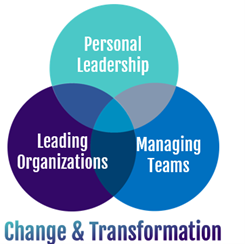
After spending time shoring up your leadership mindsets and capability, we will focus on bringing your team along on the journey. What do they need to do differently to thrive in the new normal? How do you build a high-impact team in a distributed world? How do you manage and create accountability in a distributed world? Developing vital for self-awareness, empathy, and resilience is critical for all.
Lastly, we will focus on the enterprise or business level. What does it take to creating an effective virtual workplace? Transform operations and processes to enable the virtual work and leverage next gen technology? How can we use real-time data so that operators, managers, and leaders make better decisions? We will discuss how to develop vital cross-functional collaboration to reinvent products, services, and customer relationships.

Optimal Results Require Your Full Participation
As a participant, you will experience world-class virtual learning through a digital learning model designed to adapt to each participant. Your instructor, Ms. Ennis, is an expert in digital business transformation, leadership, and high-impact teams. She will introduce each concept in ways that trigger insights for you and provide practical ways to put the idea into practice. These micro-changes add up over time to help leaders change their teams, organizations, and lives for the better. Through social learning, participants will learn from each other and build strong relationships with peers who can continue to learn from one another after the program. Each module includes interactive exercises and activities. Monthly assignments serve as the foundation for the course project, a complete business transformation plan for the virtual workplace and digital marketplace.
There are several phases to your work each month:
1. Preparation – learn the fundamentals so that you can participate fully in the workshop
2. Conversation – robust dialogue with the course leader and your fellow participants to gain a deeper understanding and perspective
3. Practice – apply what you learned to achieve small wins and embed the learning.
4. Sustaining the change – building long term habits and structures to support ongoing transformation
You cannot do this work in isolation. Your monthly projects will involve collaborating with your team and stakeholders to build alignment and interdependent solutions.
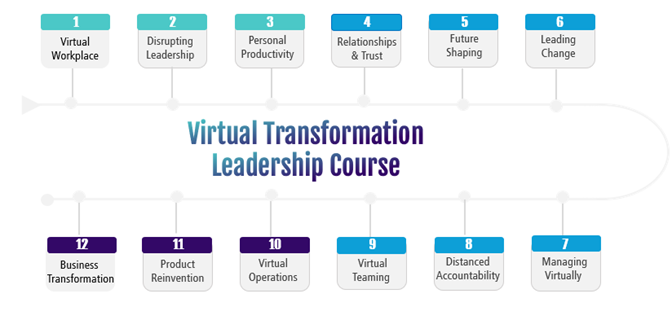
Workshop One Preparation:
● Complete the Preliminary Analysis
● Review the Executive Summary
● Review the Mission, objectives, strategies, and tasks required for completion of Module 1
● Take the assessment on your “working from home” style
● Reflect and document what you intend to achieve in this course and the predicted impact on your
organization or business.
● Organize your digital learning space
● Be ready to introduce yourself to the cohort with a two-minute introduction of yourself.
For course completion, you will learn and adopt new ways of working for yourself, institute new working practices for your team, create a plan to reinvent your company processes and operations using digital tools. We will support you with world-class methods you can use and guidance on leading change and transformation within your organization. Over the next 12 months, we will work through the following topics, guiding you through a process of reading the world, identifying new practices and change for each, culminating in a master plan for the virtual transformation plan for your business.
Executive Summary

Virtual Transformation
The first workshop in our Virtual Transformation course focuses on you as a leader and the impact you have on the organization. We will examine the forces that are driving this critical shift, what it takes to lead in a virtual environment, identify the capabilities and practices required for success, and build the foundation for the journey you will be taking over the next twelve months to lead your employees, team, and business through a significant virtual transformation. We are living in remarkable times; business and leadership are at a significant turning point. The great reset- working from home, social equity and relations, and the economy’s uncertainty- converge as a perfect storm. The silver lining is the quickened pace of digitization and the opportunity to build a more competitive, effective organization prepared for the future.
Business Transformation Process
We start with an overview of our framework for accomplishing this work together. Business transformation is different from process improvement in two significant ways. First, the starting point must be a future-focused examination of trends impacting our lives and business, before moving onto the internal analysis and design phase. We will work with you to expand your awareness, insights, and ability to connect with what those forces mean for your team, business, and customers. Secondly, the investment required to transform for success requires multi-layer, complex change and communication strategies. We will explore this in-depth and iterate through our five-step transformation process several times during the course, moving from a focus on you as a leader, to your team, to your organization and operations to your offers.
VUCA
The acronym VUCA is a powerful way of understanding the challenges of the world we live in today: it is volatile, uncertain, complex, and ambiguous. It was coined by the US Army College over 20 years ago to reflect the evolution from historical warfare and the emerging conditions that characterize our world today. Consider the shift from WW2 warfare to protecting ourselves post 9/11. We will discuss each of these components in more detail for clarity on what leaders can expect, what causes the phenomenon, where it occurs, relevance, and how it impacts the business ecosphere, your industry, and your specific situation. As with the military college, the purpose of this section is for you to understand the mechanics in order to develop strategies that are cohesive with the realities of our VUCA world, enhancing your likelihood of success. We will also view Virtual Transformation through the VUCA lens.
VUCA Leadership Response
For each of the VUCA challenges, there is a leadership response That is the good news. Deeply understanding the context provides an opportunity to quickly recognize when any of the challenges are at play, and respond with an effective practice that can make the situation workable. We cannot control the VUCA world we are in, but just as the military has we can create a new playbook to guide us in territory that is vastly different than it was in the past, adopt new practices for success. With this knowledge, you will start to rethink what you need to do to lead your employees through crises like the pandemic and deal with volatility, uncertainty, and ambiguity as it is almost always a condition of our situation. You will reflection, and share lessons learned from your personal experiences seen through this framework and trigger insights on what you need to do to develop yourself as a VUCA leader.
Industry 4.0
Today, we are in the midst of the fourth industrial revolution. It began at the dawn of the new Millennium, catalyzed by our ubiquitous use of the internet and technology in our everyday work and lives. Virtual transformation is both enabled and accelerated by the digitization of the last several decades. The boom in the Internet and telecommunication industry in the 1990s revolutionized how we connect and exchange information. It also sparked industry-wide paradigm changes, drastically altering the boundaries of the physical and the virtual world. Indeed, how would business have ever been able to continue in 2020 during the shutdown if we had not adopted the core technology that allows us to work from home, connect with customers anywhere and even manage manufacturing plants remotely? Those were the advances of Industry 3.0- Digitization. In this section, we will look back to Industry 3.0 for opportunities to jumpstart our virtual transformation with existing technology.
Then we will look forward to the future by examining the components of 4.0 to anticipate what is coming, how it will impact fundamental business structures, and what we need to do about it. The most provocative and challenging aspect of Industry 4.0 is that we are still in the midst of it; we don’t know how it all works out. Compared with previous industrial revolutions, the Fourth is evolving exponentially rather than at a linear pace. Add to that the turbo boost COVID-19 gave to the remote workforce and the economic, social, and political turbulence, and we are in for quite a ride.
Virtual workplace
Virtual working arrangements have been around for decades for a small group of employees like sales professionals whose roles by nature depend on them being more present in the field than the home office. Globalization also sparked virtual working since teams needed to collaborate across geographies. However, the true era of the virtual workplace began in March of 2020, as the Covid-19 pandemic forced everyone but essential workers to work from home. We all became virtual workers. The forced experience went better in many ways than leadership expected. Physical presence technology like Zoom helped us collectively rise to the occasion. Businesses innovated their offers to embrace the need for virtual or “touchless” products and services. We leaped ahead toward the future of work because of our forced adoption of virtual tools, practices, and mindsets. It also created vast disruption and the realization that moving forward we needed to transform the way we work to a virtual model. Amidst all of the uncertainty, we know that the future workplace will be predominantly virtual.
We can’t put the genie back in the bottle. Many companies like Twitter have already announced they will allow all of their employees to continue working remotely. Companies that choose to return to the traditional workplace will still be faced with managing work from home well into 2021 because of COVID-19. We also know that technology will disrupt the way we work and use products and services in ways we can’t even imagine today. Working virtually is enabled by technology and mandated by the growth that it creates. Industry 4.0 will continue to drive exponential change, artificial intelligence, a virtual workplace, and the need to continuously adopt new ways of working to remain competitive. With self-directed, tech-enabled, globally-connected teams, the work of managers and leaders will shift. We need to transform the way we connect, get work done, learn, transact and deliver products to customers, teach our children, and integrate work and life so that we can live productive and fulfilling lives.
Leadership Presence
In 2021 where leadership happens is very different from what you have experienced in the past. Instead of daily interactions with most of the people you are working with, you are likely leading the majority of the time over Zoom or Microsoft teams. Virtual transformation starts with you! How are you shifting the way you interact and show up to maintain the presence you had working face to face? Have you taken the time to set up your remote space in a way that lets you put your best foot forward? In the future, you undoubtedly will need to make an impact on employees, customers, bosses, and colleagues virtually more of the time if not most of the time. In fact, your leadership presence will become something that differentiates you and provides you competitive advantage. In preparation for the workshop, you will put your best foot forward to introduce yourself to your cohort colleagues and get some immediate feedback. Together we will discuss some simple new tools and practices that will quickly help you improve your performance for the work at hand. Become more conscious of and improve personal presence, specifically in the domain of virtual communication.
Virtual Communication Style
Your ability to communicate effectively as a leader is a critical success factor. Everyone has their own preferences and tendencies. Great leaders are self-aware of how they communicate, and how their communication style impacts the different types of people they work with. They also have a keen understanding of the communication style preferences that produce the best results. This work is bedrock for leadership and team development. Some of you may have used an assessment like DISC in the past.
Working virtually dramatically increases the need for communication style awareness given the lack of physical presence and ability to observe cues. When working virtually, we need to become more aware of our strengths and weaknesses and actively manage them. We don’t have our peers, leaders, and other influencers around us to help point out when we need course-correction. In addition, time and priority management are vital. Your communication style provides clues to what you need to create to be successful in a virtual or hybrid team environment. As prework, you will take the “Working From Home” style assessment. Your customized report will include suggestions to offer insight into how you might manage yourself when working virtually for the best results. We will also discuss how you can use this tool with your team.
Mindset Shifts and New Capabilities
We live in extraordinary times. There has never been a better time to lead or opportunity to lead from anywhere in the organization. Even before the pandemic, our world had become VUCA. We are well into the Fourth Industrial Revolution. Technology will continue to change faster than we can imagine. And the Covid10 pandemic has accelerated the virtual workplace.
How do we move forward and get through? Great leaders. Leaders are needed more than ever.
Today’s leaders face a dramatically different world moving forward. Transforming your team or organization starts with transforming how you work and lead. That entails adopting new ways of thinking, new behaviors, and new practices. If you have been a strong leader in the past, you will be able to build upon some of those capabilities to get even better such as communications and building relationships. In some areas, you need to literally “unlearn” some of your practices and habits to make room for the new habits of the virtual workplace. It may be the case that you have to shore up some fundamental leadership capabilities such as leading change.
So much has been written and researched on Leadership. We have synthesized the current research on t Modern Leadership and summarized it into four categories: Personal Impact, Growth Mindset, Teaming/Collaboration, and future focus. During the workshop, we will discuss specific skills and mindsets required for success in each area, and give you the opportunity to assess yourself, and identify areas to develop your leadership capabilities. The great news is that all four of these leadership areas are skills that you can get better at with effort and practice.
Leadership SWOT
A SWOT is a strategic planning tool used to identify strengths, weaknesses, opportunities, and threats a business, organization, project or competitor may have. SWOTs are high-level strategic planning tools to help organizations identify where they’re doing well and where they can improve. Knowing where you are starting from is essential for any strategic planning perspective. We will use SWOTs for several different purposes throughout this course, and we start in this workshop with your leadership SWOT. Using the spirit of this SWOT analysis – you are going to assess your own leadership skills and abilities. You will be taking the time, to be honest, and do a check-in with yourself on the quality of your work, motivations, and future self. This assessment will be critical for building your personal transformation plan to be an effective leader in the virtual workplace and have the capability to lead the transformation of your business.
Seize Tomorrow: Designing Your Future State
Once you have a clear perspective of your current state, we will turn the conversation to the future. Based on your understanding of the forces that are impacting our world, how do you need to shift yourself as a leader, the way your team works, and how your business compete? What is the picture you must paint of the future to get people to follow you? What do you anticipate based on the trends you have researched, and how will you prepare for a future, unlike the past.
Influencing and Leading Change
As we note at the start of this executive summary great leaders are needed now more than ever to help their organizations grow and flourish in the virtual workplace and economy. As a leader you must hone the ability to influence and lead change by mastering the fundamental practices that are required for successful transformation:
1. Bridge the gap between vision and implementation
2. Rigorously plan for the people component
3. Get clear how work will be different
4. Engaged stakeholders for collaboration and creativity
5. Understand and mitigate the impact
6. Embody change leadership and manage transitions
7. Distribute accountability throughout the system
8. Adopt new ways of working and enable employees to succeed using them
9. Build communities for velocity, energy, and capacity for future change
Making it Real
At the end of each workshop, we will collectively turn our focus into how you as a leader will make what we have covered real in your organization. By making it real we mean to apply what you have learned and take action to make a positive impact. That starts with reflection on what you are going to do differently yourself and a commitment to change. Also important is how you will bring the others in your organization into the conversation about what you have learned, and make requests about what you need from them for success. This will include not only your formal team but your cross-functional peers. How will you collectively build the plan to transform yourselves into a virtual organization?
Curriculum
Workshop 1 – Internal Analysis
- Part 1 Virtual Workplace
- Part 2 Disrupting Leadership
- Part 3 Personal Productivity
- Part 4 Relationships and Trust
- Part 5 Future Shaping
- Part 6 Leading Change
- Part 7 Managing Virtually
- Part 8 Distanced Accountability
- Part 9 Virtual Teaming
- Part 10 Virtual Operations
- Part 11 Product Reinvention
- Part 12 Business Transformation
Distance Learning
Introduction
Welcome to Appleton Greene and thank you for enrolling on the Virtual Transformation corporate training program. You will be learning through our unique facilitation via distance-learning method, which will enable you to practically implement everything that you learn academically. The methods and materials used in your program have been designed and developed to ensure that you derive the maximum benefits and enjoyment possible. We hope that you find the program challenging and fun to do. However, if you have never been a distance-learner before, you may be experiencing some trepidation at the task before you. So we will get you started by giving you some basic information and guidance on how you can make the best use of the modules, how you should manage the materials and what you should be doing as you work through them. This guide is designed to point you in the right direction and help you to become an effective distance-learner. Take a few hours or so to study this guide and your guide to tutorial support for students, while making notes, before you start to study in earnest.
Study environment
You will need to locate a quiet and private place to study, preferably a room where you can easily be isolated from external disturbances or distractions. Make sure the room is well-lit and incorporates a relaxed, pleasant feel. If you can spoil yourself within your study environment, you will have much more of a chance to ensure that you are always in the right frame of mind when you do devote time to study. For example, a nice fire, the ability to play soft soothing background music, soft but effective lighting, perhaps a nice view if possible and a good size desk with a comfortable chair. Make sure that your family know when you are studying and understand your study rules. Your study environment is very important. The ideal situation if at all possible, is to have a separate study, which can be devoted to you. If this is not possible then you will need to pay a lot more attention to developing and managing your study schedule, because it will affect other people as well as yourself. The better your study environment, the more productive you will be.
Study tools & rules
Try and make sure that your study tools are sufficient and in good working order. You will need to have access to a computer, scanner and printer, with access to the internet. You will need a very comfortable chair, which supports your lower back, and you will need a good filing system. It can be very frustrating if you are spending valuable study time trying to fix study tools that are unreliable, or unsuitable for the task. Make sure that your study tools are up to date. You will also need to consider some study rules. Some of these rules will apply to you and will be intended to help you to be more disciplined about when and how you study. This distance-learning guide will help you and after you have read it you can put some thought into what your study rules should be. You will also need to negotiate some study rules for your family, friends or anyone who lives with you. They too will need to be disciplined to ensure that they can support you while you study. It is important to ensure that your family and friends are an integral part of your study team. Having their support and encouragement can prove to be a crucial contribution to your successful completion of the program. Involve them in as much as you can.
Successful distance-learning
Distance-learners are freed from the necessity of attending regular classes or workshops, since they can study in their own way, at their own pace and for their own purposes. But unlike traditional internal training courses, it is the student’s responsibility, with a distance-learning program, to ensure that they manage their own study contribution. This requires strong self-discipline and self-motivation skills and there must be a clear will to succeed. Those students who are used to managing themselves, are good at managing others and who enjoy working in isolation, are more likely to be good distance-learners. It is also important to be aware of the main reasons why you are studying and of the main objectives that you are hoping to achieve as a result. You will need to remind yourself of these objectives at times when you need to motivate yourself. Never lose sight of your long-term goals and your short-term objectives. There is nobody available here to pamper you, or to look after you, or to spoon-feed you with information, so you will need to find ways to encourage and appreciate yourself while you are studying. Make sure that you chart your study progress, so that you can be sure of your achievements and re-evaluate your goals and objectives regularly.
Self-assessment
Appleton Greene training programs are in all cases post-graduate programs. Consequently, you should already have obtained a business-related degree and be an experienced learner. You should therefore already be aware of your study strengths and weaknesses. For example, which time of the day are you at your most productive? Are you a lark or an owl? What study methods do you respond to the most? Are you a consistent learner? How do you discipline yourself? How do you ensure that you enjoy yourself while studying? It is important to understand yourself as a learner and so some self-assessment early on will be necessary if you are to apply yourself correctly. Perform a SWOT analysis on yourself as a student. List your internal strengths and weaknesses as a student and your external opportunities and threats. This will help you later on when you are creating a study plan. You can then incorporate features within your study plan that can ensure that you are playing to your strengths, while compensating for your weaknesses. You can also ensure that you make the most of your opportunities, while avoiding the potential threats to your success.
Accepting responsibility as a student
Training programs invariably require a significant investment, both in terms of what they cost and in the time that you need to contribute to study and the responsibility for successful completion of training programs rests entirely with the student. This is never more apparent than when a student is learning via distance-learning. Accepting responsibility as a student is an important step towards ensuring that you can successfully complete your training program. It is easy to instantly blame other people or factors when things go wrong. But the fact of the matter is that if a failure is your failure, then you have the power to do something about it, it is entirely in your own hands. If it is always someone else’s failure, then you are powerless to do anything about it. All students study in entirely different ways, this is because we are all individuals and what is right for one student, is not necessarily right for another. In order to succeed, you will have to accept personal responsibility for finding a way to plan, implement and manage a personal study plan that works for you. If you do not succeed, you only have yourself to blame.
Planning
By far the most critical contribution to stress, is the feeling of not being in control. In the absence of planning we tend to be reactive and can stumble from pillar to post in the hope that things will turn out fine in the end. Invariably they don’t! In order to be in control, we need to have firm ideas about how and when we want to do things. We also need to consider as many possible eventualities as we can, so that we are prepared for them when they happen. Prescriptive Change, is far easier to manage and control, than Emergent Change. The same is true with distance-learning. It is much easier and much more enjoyable, if you feel that you are in control and that things are going to plan. Even when things do go wrong, you are prepared for them and can act accordingly without any unnecessary stress. It is important therefore that you do take time to plan your studies properly.
Management
Once you have developed a clear study plan, it is of equal importance to ensure that you manage the implementation of it. Most of us usually enjoy planning, but it is usually during implementation when things go wrong. Targets are not met and we do not understand why. Sometimes we do not even know if targets are being met. It is not enough for us to conclude that the study plan just failed. If it is failing, you will need to understand what you can do about it. Similarly if your study plan is succeeding, it is still important to understand why, so that you can improve upon your success. You therefore need to have guidelines for self-assessment so that you can be consistent with performance improvement throughout the program. If you manage things correctly, then your performance should constantly improve throughout the program.
Study objectives & tasks
The first place to start is developing your program objectives. These should feature your reasons for undertaking the training program in order of priority. Keep them succinct and to the point in order to avoid confusion. Do not just write the first things that come into your head because they are likely to be too similar to each other. Make a list of possible departmental headings, such as: Customer Service; E-business; Finance; Globalization; Human Resources; Technology; Legal; Management; Marketing and Production. Then brainstorm for ideas by listing as many things that you want to achieve under each heading and later re-arrange these things in order of priority. Finally, select the top item from each department heading and choose these as your program objectives. Try and restrict yourself to five because it will enable you to focus clearly. It is likely that the other things that you listed will be achieved if each of the top objectives are achieved. If this does not prove to be the case, then simply work through the process again.
Study forecast
As a guide, the Appleton Greene Virtual Transformation corporate training program should take 12-18 months to complete, depending upon your availability and current commitments. The reason why there is such a variance in time estimates is because every student is an individual, with differing productivity levels and different commitments. These differentiations are then exaggerated by the fact that this is a distance-learning program, which incorporates the practical integration of academic theory as an as a part of the training program. As such all of the project studies are real, which means that important decisions and compromises need to be made. You will want to get things right and will need to be patient with your expectations to ensure that they are. We would always recommend that you are prudent with your own task and time forecasts, but you still need to develop them and have a clear indication of what are realistic expectations in your case. With reference to your time planning: consider the time that you can realistically dedicate towards study with the program every week; calculate how long it should take you to complete the program, using the guidelines featured here; then break the program down into logical modules and allocate a suitable proportion of time to each of them, these will be your milestones; you can create a time plan by using a spreadsheet on your computer, or a personal organizer such as MS Outlook, you could also use a financial forecasting software; break your time forecasts down into manageable chunks of time, the more specific you can be, the more productive and accurate your time management will be; finally, use formulas where possible to do your time calculations for you, because this will help later on when your forecasts need to change in line with actual performance. With reference to your task planning: refer to your list of tasks that need to be undertaken in order to achieve your program objectives; with reference to your time plan, calculate when each task should be implemented; remember that you are not estimating when your objectives will be achieved, but when you will need to focus upon implementing the corresponding tasks; you also need to ensure that each task is implemented in conjunction with the associated training modules which are relevant; then break each single task down into a list of specific to do’s, say approximately ten to do’s for each task and enter these into your study plan; once again you could use MS Outlook to incorporate both your time and task planning and this could constitute your study plan; you could also use a project management software like MS Project. You should now have a clear and realistic forecast detailing when you can expect to be able to do something about undertaking the tasks to achieve your program objectives.
Performance management
It is one thing to develop your study forecast, it is quite another to monitor your progress. Ultimately it is less important whether you achieve your original study forecast and more important that you update it so that it constantly remains realistic in line with your performance. As you begin to work through the program, you will begin to have more of an idea about your own personal performance and productivity levels as a distance-learner. Once you have completed your first study module, you should re-evaluate your study forecast for both time and tasks, so that they reflect your actual performance level achieved. In order to achieve this you must first time yourself while training by using an alarm clock. Set the alarm for hourly intervals and make a note of how far you have come within that time. You can then make a note of your actual performance on your study plan and then compare your performance against your forecast. Then consider the reasons that have contributed towards your performance level, whether they are positive or negative and make a considered adjustment to your future forecasts as a result. Given time, you should start achieving your forecasts regularly.
With reference to time management: time yourself while you are studying and make a note of the actual time taken in your study plan; consider your successes with time-efficiency and the reasons for the success in each case and take this into consideration when reviewing future time planning; consider your failures with time-efficiency and the reasons for the failures in each case and take this into consideration when reviewing future time planning; re-evaluate your study forecast in relation to time planning for the remainder of your training program to ensure that you continue to be realistic about your time expectations. You need to be consistent with your time management, otherwise you will never complete your studies. This will either be because you are not contributing enough time to your studies, or you will become less efficient with the time that you do allocate to your studies. Remember, if you are not in control of your studies, they can just become yet another cause of stress for you.
With reference to your task management: time yourself while you are studying and make a note of the actual tasks that you have undertaken in your study plan; consider your successes with task-efficiency and the reasons for the success in each case; take this into consideration when reviewing future task planning; consider your failures with task-efficiency and the reasons for the failures in each case and take this into consideration when reviewing future task planning; re-evaluate your study forecast in relation to task planning for the remainder of your training program to ensure that you continue to be realistic about your task expectations. You need to be consistent with your task management, otherwise you will never know whether you are achieving your program objectives or not.
Keeping in touch
You will have access to qualified and experienced professors and tutors who are responsible for providing tutorial support for your particular training program. So don’t be shy about letting them know how you are getting on. We keep electronic records of all tutorial support emails so that professors and tutors can review previous correspondence before considering an individual response. It also means that there is a record of all communications between you and your professors and tutors and this helps to avoid any unnecessary duplication, misunderstanding, or misinterpretation. If you have a problem relating to the program, share it with them via email. It is likely that they have come across the same problem before and are usually able to make helpful suggestions and steer you in the right direction. To learn more about when and how to use tutorial support, please refer to the Tutorial Support section of this student information guide. This will help you to ensure that you are making the most of tutorial support that is available to you and will ultimately contribute towards your success and enjoyment with your training program.
Work colleagues and family
You should certainly discuss your program study progress with your colleagues, friends and your family. Appleton Greene training programs are very practical. They require you to seek information from other people, to plan, develop and implement processes with other people and to achieve feedback from other people in relation to viability and productivity. You will therefore have plenty of opportunities to test your ideas and enlist the views of others. People tend to be sympathetic towards distance-learners, so don’t bottle it all up in yourself. Get out there and share it! It is also likely that your family and colleagues are going to benefit from your labors with the program, so they are likely to be much more interested in being involved than you might think. Be bold about delegating work to those who might benefit themselves. This is a great way to achieve understanding and commitment from people who you may later rely upon for process implementation. Share your experiences with your friends and family.
Making it relevant
The key to successful learning is to make it relevant to your own individual circumstances. At all times you should be trying to make bridges between the content of the program and your own situation. Whether you achieve this through quiet reflection or through interactive discussion with your colleagues, client partners or your family, remember that it is the most important and rewarding aspect of translating your studies into real self-improvement. You should be clear about how you want the program to benefit you. This involves setting clear study objectives in relation to the content of the course in terms of understanding, concepts, completing research or reviewing activities and relating the content of the modules to your own situation. Your objectives may understandably change as you work through the program, in which case you should enter the revised objectives on your study plan so that you have a permanent reminder of what you are trying to achieve, when and why.
Distance-learning check-list
Prepare your study environment, your study tools and rules.
Undertake detailed self-assessment in terms of your ability as a learner.
Create a format for your study plan.
Consider your study objectives and tasks.
Create a study forecast.
Assess your study performance.
Re-evaluate your study forecast.
Be consistent when managing your study plan.
Use your Appleton Greene Certified Learning Provider (CLP) for tutorial support.
Make sure you keep in touch with those around you.
Tutorial Support
Programs
Appleton Greene uses standard and bespoke corporate training programs as vessels to transfer business process improvement knowledge into the heart of our clients’ organizations. Each individual program focuses upon the implementation of a specific business process, which enables clients to easily quantify their return on investment. There are hundreds of established Appleton Greene corporate training products now available to clients within customer services, e-business, finance, globalization, human resources, information technology, legal, management, marketing and production. It does not matter whether a client’s employees are located within one office, or an unlimited number of international offices, we can still bring them together to learn and implement specific business processes collectively. Our approach to global localization enables us to provide clients with a truly international service with that all important personal touch. Appleton Greene corporate training programs can be provided virtually or locally and they are all unique in that they individually focus upon a specific business function. They are implemented over a sustainable period of time and professional support is consistently provided by qualified learning providers and specialist consultants.
Support available
You will have a designated Certified Learning Provider (CLP) and an Accredited Consultant and we encourage you to communicate with them as much as possible. In all cases tutorial support is provided online because we can then keep a record of all communications to ensure that tutorial support remains consistent. You would also be forwarding your work to the tutorial support unit for evaluation and assessment. You will receive individual feedback on all of the work that you undertake on a one-to-one basis, together with specific recommendations for anything that may need to be changed in order to achieve a pass with merit or a pass with distinction and you then have as many opportunities as you may need to re-submit project studies until they meet with the required standard. Consequently the only reason that you should really fail (CLP) is if you do not do the work. It makes no difference to us whether a student takes 12 months or 18 months to complete the program, what matters is that in all cases the same quality standard will have been achieved.
Support Process
Please forward all of your future emails to the designated (CLP) Tutorial Support Unit email address that has been provided and please do not duplicate or copy your emails to other AGC email accounts as this will just cause unnecessary administration. Please note that emails are always answered as quickly as possible but you will need to allow a period of up to 20 business days for responses to general tutorial support emails during busy periods, because emails are answered strictly within the order in which they are received. You will also need to allow a period of up to 30 business days for the evaluation and assessment of project studies. This does not include weekends or public holidays. Please therefore kindly allow for this within your time planning. All communications are managed online via email because it enables tutorial service support managers to review other communications which have been received before responding and it ensures that there is a copy of all communications retained on file for future reference. All communications will be stored within your personal (CLP) study file here at Appleton Greene throughout your designated study period. If you need any assistance or clarification at any time, please do not hesitate to contact us by forwarding an email and remember that we are here to help. If you have any questions, please list and number your questions succinctly and you can then be sure of receiving specific answers to each and every query.
Time Management
It takes approximately 1 Year to complete the Virtual Transformation corporate training program, incorporating 12 x 6-hour monthly workshops. Each student will also need to contribute approximately 4 hours per week over 1 Year of their personal time. Students can study from home or work at their own pace and are responsible for managing their own study plan. There are no formal examinations and students are evaluated and assessed based upon their project study submissions, together with the quality of their internal analysis and supporting documents. They can contribute more time towards study when they have the time to do so and can contribute less time when they are busy. All students tend to be in full time employment while studying and the Virtual Transformation program is purposely designed to accommodate this, so there is plenty of flexibility in terms of time management. It makes no difference to us at Appleton Greene, whether individuals take 12-18 months to complete this program. What matters is that in all cases the same standard of quality will have been achieved with the standard and bespoke programs that have been developed.
Distance Learning Guide
The distance learning guide should be your first port of call when starting your training program. It will help you when you are planning how and when to study, how to create the right environment and how to establish the right frame of mind. If you can lay the foundations properly during the planning stage, then it will contribute to your enjoyment and productivity while training later. The guide helps to change your lifestyle in order to accommodate time for study and to cultivate good study habits. It helps you to chart your progress so that you can measure your performance and achieve your goals. It explains the tools that you will need for study and how to make them work. It also explains how to translate academic theory into practical reality. Spend some time now working through your distance learning guide and make sure that you have firm foundations in place so that you can make the most of your distance learning program. There is no requirement for you to attend training workshops or classes at Appleton Greene offices. The entire program is undertaken online, program course manuals and project studies are administered via the Appleton Greene web site and via email, so you are able to study at your own pace and in the comfort of your own home or office as long as you have a computer and access to the internet.
How To Study
The how to study guide provides students with a clear understanding of the Appleton Greene facilitation via distance learning training methods and enables students to obtain a clear overview of the training program content. It enables students to understand the step-by-step training methods used by Appleton Greene and how course manuals are integrated with project studies. It explains the research and development that is required and the need to provide evidence and references to support your statements. It also enables students to understand precisely what will be required of them in order to achieve a pass with merit and a pass with distinction for individual project studies and provides useful guidance on how to be innovative and creative when developing your Unique Program Proposition (UPP).
Tutorial Support
Tutorial support for the Appleton Greene ed corporate training program is provided online either through the Appleton Greene Client Support Portal (CSP), or via email. All tutorial support requests are facilitated by a designated Program Administration Manager (PAM). They are responsible for deciding which professor or tutor is the most appropriate option relating to the support required and then the tutorial support request is forwarded onto them. Once the professor or tutor has completed the tutorial support request and answered any questions that have been asked, this communication is then returned to the student via email by the designated Program Administration Manager (PAM). This enables all tutorial support, between students, professors and tutors, to be facilitated by the designated Program Administration Manager (PAM) efficiently and securely through the email account. You will therefore need to allow a period of up to 20 business days for responses to general support queries and up to 30 business days for the evaluation and assessment of project studies, because all tutorial support requests are answered strictly within the order in which they are received. This does not include weekends or public holidays. Consequently you need to put some thought into the management of your tutorial support procedure in order to ensure that your study plan is feasible and to obtain the maximum possible benefit from tutorial support during your period of study. Please retain copies of your tutorial support emails for future reference. Please ensure that ALL of your tutorial support emails are set out using the format as suggested within your guide to tutorial support. Your tutorial support emails need to be referenced clearly to the specific part of the course manual or project study which you are working on at any given time. You also need to list and number any questions that you would like to ask, up to a maximum of five questions within each tutorial support email. Remember the more specific you can be with your questions the more specific your answers will be too and this will help you to avoid any unnecessary misunderstanding, misinterpretation, or duplication. The guide to tutorial support is intended to help you to understand how and when to use support in order to ensure that you get the most out of your training program. Appleton Greene training programs are designed to enable you to do things for yourself. They provide you with a structure or a framework and we use tutorial support to facilitate students while they practically implement what they learn. In other words, we are enabling students to do things for themselves. The benefits of distance learning via facilitation are consider. Consequently you should learn how and when to use tutorial support so that you can maximize the benefits from your learning experience with Appleton Greene. This guide describes the purpose of each training function and how to use them and how to use tutorial support in relation to each aspect of the training program. It also provides useful tips and guidance with regard to best practice.
Tutorial Support Tips
Students are often unsure about how and when to use tutorial support with Appleton Greene. This Tip List will help you to understand more about how to achieve the most from using tutorial support. Refer to it regularly to ensure that you are continuing to use the service properly. Tutorial support is critical to the success of your training experience, but it is important to understand when and how to use it in order to maximize the benefit that you receive. It is no coincidence that those students who succeed are those that learn how to be positive, proactive and productive when using tutorial support.
Be positive and friendly with your tutorial support emails
Remember that if you forward an email to the tutorial support unit, you are dealing with real people. “Do unto others as you would expect others to do unto you”. If you are positive, complimentary and generally friendly in your emails, you will generate a similar response in return. This will be more enjoyable, productive and rewarding for you in the long-term.
Think about the impression that you want to create
Every time that you communicate, you create an impression, which can be either positive or negative, so put some thought into the impression that you want to create. Remember that copies of all tutorial support emails are stored electronically and tutors will always refer to prior correspondence before responding to any current emails. Over a period of time, a general opinion will be arrived at in relation to your character, attitude and ability. Try to manage your own frustrations, mood swings and temperament professionally, without involving the tutorial support team. Demonstrating frustration or a lack of patience is a weakness and will be interpreted as such. The good thing about communicating in writing, is that you will have the time to consider your content carefully, you can review it and proof-read it before sending your email to Appleton Greene and this should help you to communicate more professionally, consistently and to avoid any unnecessary knee-jerk reactions to individual situations as and when they may arise. Please also remember that the CLP Tutorial Support Unit will not just be responsible for evaluating and assessing the quality of your work, they will also be responsible for providing recommendations to other learning providers and to client contacts within the Appleton Greene global client network, so do be in control of your own emotions and try to create a good impression.
Remember that quality is preferred to quantity
Please remember that when you send an email to the tutorial support team, you are not using Twitter or Text Messaging. Try not to forward an email every time that you have a thought. This will not prove to be productive either for you or for the tutorial support team. Take time to prepare your communications properly, as if you were writing a professional letter to a business colleague and make a list of queries that you are likely to have and then incorporate them within one email, say once every month, so that the tutorial support team can understand more about context, application and your methodology for study. Get yourself into a consistent routine with your tutorial support requests and use the tutorial support template provided with ALL of your emails. The (CLP) Tutorial Support Unit will not spoon-feed you with information. They need to be able to evaluate and assess your tutorial support requests carefully and professionally.
Be specific about your questions in order to receive specific answers
Try not to write essays by thinking as you are writing tutorial support emails. The tutorial support unit can be unclear about what in fact you are asking, or what you are looking to achieve. Be specific about asking questions that you want answers to. Number your questions. You will then receive specific answers to each and every question. This is the main purpose of tutorial support via email.
Keep a record of your tutorial support emails
It is important that you keep a record of all tutorial support emails that are forwarded to you. You can then refer to them when necessary and it avoids any unnecessary duplication, misunderstanding, or misinterpretation.
Tutorial Support Email Format
You should use this tutorial support format if you need to request clarification or assistance while studying with your training program. Please note that ALL of your tutorial support request emails should use the same format. You should therefore set up a standard email template, which you can then use as and when you need to. Emails that are forwarded to Appleton Greene, which do not use the following format, may be rejected and returned to you by the (CLP) Program Administration Manager. A detailed response will then be forwarded to you via email usually within 20 business days of receipt for general support queries and 30 business days for the evaluation and assessment of project studies. This does not include weekends or public holidays. Your tutorial support request, together with the corresponding TSU reply, will then be saved and stored within your electronic TSU file at Appleton Greene for future reference.
Subject line of your email
Please insert: Appleton Greene (CLP) Tutorial Support Request: (Your Full Name) (Date), within the subject line of your email.
Main body of your email
Please insert:
1. Appleton Greene Certified Learning Provider (CLP) Tutorial Support Request
2. Your Full Name
3. Date of TS request
4. Preferred email address
5. Backup email address
6. Course manual page name or number (reference)
7. Project study page name or number (reference)
Subject of enquiry
Please insert a maximum of 50 words (please be succinct)
Briefly outline the subject matter of your inquiry, or what your questions relate to.
Question 1
Maximum of 50 words (please be succinct)
Maximum of 50 words (please be succinct)
Question 3
Maximum of 50 words (please be succinct)
Question 4
Maximum of 50 words (please be succinct)
Question 5
Maximum of 50 words (please be succinct)
Please note that a maximum of 5 questions is permitted with each individual tutorial support request email.
Procedure
* List the questions that you want to ask first, then re-arrange them in order of priority. Make sure that you reference them, where necessary, to the course manuals or project studies.
* Make sure that you are specific about your questions and number them. Try to plan the content within your emails to make sure that it is relevant.
* Make sure that your tutorial support emails are set out correctly, using the Tutorial Support Email Format provided here.
* Save a copy of your email and incorporate the date sent after the subject title. Keep your tutorial support emails within the same file and in date order for easy reference.
* Allow up to 20 business days for a response to general tutorial support emails and up to 30 business days for the evaluation and assessment of project studies, because detailed individual responses will be made in all cases and tutorial support emails are answered strictly within the order in which they are received.
* Emails can and do get lost. So if you have not received a reply within the appropriate time, forward another copy or a reminder to the tutorial support unit to be sure that it has been received but do not forward reminders unless the appropriate time has elapsed.
* When you receive a reply, save it immediately featuring the date of receipt after the subject heading for easy reference. In most cases the tutorial support unit replies to your questions individually, so you will have a record of the questions that you asked as well as the answers offered. With project studies however, separate emails are usually forwarded by the tutorial support unit, so do keep a record of your own original emails as well.
* Remember to be positive and friendly in your emails. You are dealing with real people who will respond to the same things that you respond to.
* Try not to repeat questions that have already been asked in previous emails. If this happens the tutorial support unit will probably just refer you to the appropriate answers that have already been provided within previous emails.
* If you lose your tutorial support email records you can write to Appleton Greene to receive a copy of your tutorial support file, but a separate administration charge may be levied for this service.
How To Study
How To Study
Planning your study environment
Your study conditions are of great importance and will have a direct effect on how much you enjoy your training program. Consider how much space you will have, whether it is comfortable and private and whether you are likely to be disturbed. The study tools and facilities at your disposal are also important to the success of your distance-learning experience. Your tutorial support unit can help with useful tips and guidance, regardless of your starting position. It is important to get this right before you start working on your training program.
Planning your program objectives
It is important that you have a clear list of study objectives, in order of priority, before you start working on your training program. Your tutorial support unit can offer assistance here to ensure that your study objectives have been afforded due consideration and priority.
Planning how and when to study
Distance-learners are freed from the necessity of attending regular classes, since they can study in their own way, at their own pace and for their own purposes. This approach is designed to let you study efficiently away from the traditional classroom environment. It is important however, that you plan how and when to study, so that you are making the most of your natural attributes, strengths and opportunities. Your tutorial support unit can offer assistance and useful tips to ensure that you are playing to your strengths.
Planning your study tasks
You should have a clear understanding of the study tasks that you should be undertaking and the priority associated with each task. These tasks should also be integrated with your program objectives. The distance learning guide and the guide to tutorial support for students should help you here, but if you need any clarification or assistance, please contact your tutorial support unit.
Planning your time
You will need to allocate specific times during your calendar when you intend to study if you are to have a realistic chance of completing your program on time. You are responsible for planning and managing your own study time, so it is important that you are successful with this. Your tutorial support unit can help you with this if your time plan is not working.
Keeping in touch
Consistency is the key here. If you communicate too frequently in short bursts, or too infrequently with no pattern, then your management ability with your studies will be questioned, both by you and by your tutorial support unit. It is obvious when a student is in control and when one is not and this will depend how able you are at sticking with your study plan. Inconsistency invariably leads to in-completion.
Charting your progress
Your tutorial support team can help you to chart your own study progress. Refer to your distance learning guide for further details.
Making it work
To succeed, all that you will need to do is apply yourself to undertaking your training program and interpreting it correctly. Success or failure lies in your hands and your hands alone, so be sure that you have a strategy for making it work. Your Certified Learning Provider (CLP) and Accredited Consultant can guide you through the process of program planning, development and implementation.
Reading methods
Interpretation is often unique to the individual but it can be improved and even quantified by implementing consistent interpretation methods. Interpretation can be affected by outside interference such as family members, TV, or the Internet, or simply by other thoughts which are demanding priority in our minds. One thing that can improve our productivity is using recognized reading methods. This helps us to focus and to be more structured when reading information for reasons of importance, rather than relaxation.
Speed reading
When reading through course manuals for the first time, subconsciously set your reading speed to be just fast enough that you cannot dwell on individual words or tables. With practice, you should be able to read an A4 sheet of paper in one minute. You will not achieve much in the way of a detailed understanding, but your brain will retain a useful overview. This overview will be important later on and will enable you to keep individual issues in perspective with a more generic picture because speed reading appeals to the memory part of the brain. Do not worry about what you do or do not remember at this stage.
Content reading
Once you have speed read everything, you can then start work in earnest. You now need to read a particular section of your course manual thoroughly, by making detailed notes while you read. This process is called Content Reading and it will help to consolidate your understanding and interpretation of the information that has been provided.
Making structured notes on the course manuals
When you are content reading, you should be making detailed notes, which are both structured and informative. Make these notes in a MS Word document on your computer, because you can then amend and update these as and when you deem it to be necessary. List your notes under three headings: 1. Interpretation – 2.Questions – 3. Tasks. The purpose of the 1st section is to clarify your interpretation by writing it down. The purpose of the 2nd section is to list any questions that the issue raises for you. The purpose of the 3rd section is to list any tasks that you should undertake as a result. Anyone who has graduated with a business-related degree should already be familiar with this process.
Organizing structured notes separately
You should then transfer your notes to a separate study notebook, preferably one that enables easy referencing, such as a MS Word Document, a MS Excel Spreadsheet, a MS Access Database, or a personal organizer on your cell phone. Transferring your notes allows you to have the opportunity of cross-checking and verifying them, which assists considerably with understanding and interpretation. You will also find that the better you are at doing this, the more chance you will have of ensuring that you achieve your study objectives.
Question your understanding
Do challenge your understanding. Explain things to yourself in your own words by writing things down.
Clarifying your understanding
If you are at all unsure, forward an email to your tutorial support unit and they will help to clarify your understanding.
Question your interpretation
Do challenge your interpretation. Qualify your interpretation by writing it down.
Clarifying your interpretation
If you are at all unsure, forward an email to your tutorial support unit and they will help to clarify your interpretation.
Qualification Requirements
The student will need to successfully complete the project study and all of the exercises relating to the Virtual Transformation corporate training program, achieving a pass with merit or distinction in each case, in order to qualify as an Accredited Virtual Transformation Specialist (AVTS). All monthly workshops need to be tried and tested within your company. These project studies can be completed in your own time and at your own pace and in the comfort of your own home or office. There are no formal examinations, assessment is based upon the successful completion of the project studies. They are called project studies because, unlike case studies, these projects are not theoretical, they incorporate real program processes that need to be properly researched and developed. The project studies assist us in measuring your understanding and interpretation of the training program and enable us to assess qualification merits. All of the project studies are based entirely upon the content within the training program and they enable you to integrate what you have learnt into your corporate training practice.
Collaborative Evaluation – Grading Contribution
Project Study – Grading Contribution
Customer Service – 10%
E-business – 05%
Finance – 10%
Globalization – 10%
Human Resources – 10%
Information Technology – 10%
Legal – 05%
Management – 10%
Marketing – 10%
Production – 10%
Education – 05%
Logistics – 05%
TOTAL GRADING – 100%
Qualification grades
A mark of 90% = Pass with Distinction.
A mark of 75% = Pass with Merit.
A mark of less than 75% = Fail.
If you fail to achieve a mark of 75% with a project study, you will receive detailed feedback from the Certified Learning Provider (CLP) and/or Accredited Consultant, together with a list of tasks which you will need to complete, in order to ensure that your project study meets with the minimum quality standard that is required by Appleton Greene. You can then re-submit your project study for further evaluation and assessment. Indeed you can re-submit as many drafts of your project studies as you need to, until such a time as they eventually meet with the required standard by Appleton Greene, so you need not worry about this, it is all part of the learning process.
When marking project studies, Appleton Greene is looking for sufficient evidence of the following:
Pass with merit
A satisfactory level of program understanding
A satisfactory level of program interpretation
A satisfactory level of project study content presentation
A satisfactory level of Unique Program Proposition (UPP) quality
A satisfactory level of the practical integration of academic theory
Pass with distinction
An exceptional level of program understanding
An exceptional level of program interpretation
An exceptional level of project study content presentation
An exceptional level of Unique Program Proposition (UPP) quality
An exceptional level of the practical integration of academic theory
Preliminary Analysis

The world is at a historic crossroads, as economies everywhere attempt to pull themselves out of a COVID-19-induced hiatus. The damage inflicted has been horrific in terms of lives taken and livelihoods lost. However, it also presents an opportunity to rebuild in a more inclusive and responsible way. Coronavirus-related lockdowns provided a glimpse of what is possible in terms of limiting pollution, and the pandemic’s human toll illustrated what can happen when healthcare systems and social safety nets are neglected. Now, it is up to leaders in the private and public sectors to seize the moment and help create a more equitable and sustainable society.
The Virtual Workplace is Here To Stay
Virtual employees have been around for over 30 years. However, today we are experiencing a sudden and unprecedented level of teams made up of people working remotely because of the pandemic. Everyone who could work from home began to work virtually.
Virtual leadership requires leaders to employ a unique set of skills to coordinate group work and build relationships with followers, whether it be a 1-1 relationship with a remote employee or a set of relationships with members of a virtual team. A recent survey of leaders reflects a widespread agreement that virtual leadership requires more from leaders: 87% of leaders—and 92% of senior executives—agreed or strongly agreed that virtual leadership requires a different set of skills than face-to-face leadership (Center for Creative Leadership, 2007).
Since virtual work happens in a different location than the traditional site of a business, it creates distance between the plant or office, tools, employees, and management. As a result, both complex challenges and transformational opportunities arise for companies. Working virtually at scale is enabled by relatively recent advances in communications and access to information. Virtual work represents a significant transformation and turning point for business, our economy, and the way we live.
Over the last twenty years, working virtually has grown in waves. In addition to freelancers, more corporate employees became virtual. The reality of working odd hours because colleagues were in time zones across the globe, 9/11 and the SARS pandemic began to usher in employees and corporations’ willingness to embrace virtual work arrangements. Sales professionals are traditionally virtual to be close to customers. However, adoption within other parts of the workforce was slow, given the inherent complexities and management cynicism about effectively managing people in a virtual environment.
And then, in March of 2020, the Covid-19 pandemic forced everyone but essential workers to work from home. We all became virtual workers. The forced experience went better in many ways than leadership expected. Physical presence technology like Zoom helped us collectively rise to the occasion. Businesses innovated their offers to embrace the need for virtual or “touchless” products and services. We leaped ahead toward the future of work because of our forced adoption of virtual tools, practices, and mindsets. To prepare yourself for the course, check out this collection of articles to lead virtually and manage remote teams.
Industry 4.0
Industry 4.0, developed by German economist Klaus Schwab, is useful for understanding the historical context and importance of virtual business and related trends. In the 18th century, The first industrial revolution enabled mechanical production powered by water and steam-powered machines. With this newly found capability to produce goods at scale, small businesses grew from serving small, local customers to large organizations with owners, managers, and employees. Industry began to replace agriculture as the economic backbone of our society. The work was primarily physical, which needed to be done exclusively at the plant. Employees worked at the factory in their hometown, close by, and usually during the same hours as their co-workers.
The beginning of the 20th century marked the start of the second industrial revolution with electricity as the catalyst. Ford established the first assembly line, turbocharging the mass production of goods. The telephone and telegraph sparked new communications capabilities that eventually lead to an even more significant transformation in the way we work. Management techniques such as division of labor, just-in-time manufacturing, and lean manufacturing principles refined the underlying processes leading to improved quality and output. The factory remained the exclusive domain for work to get done. It was not yet possible to be productive without being at the plant at a scheduled time to enable workflow.
During the third industrial revolution marked by the invention of computers and electronics in the 1960s, transistors and integrated circuits enabled the automation of machines and work processes. This period resulted in reduced effort, increased speed, greater accuracy, and even workforce replacement in some cases. The hardware and software industries proliferated, integrating and transforming management processes such as enterprise resource planning, inventory management, shipping logistics, product flow scheduling, and tracking throughout the factory. The modern-day knowledge worker was born; a whole population segment needed more for their intellect than for physical work. It was during this period that the virtual worker emerged. New communications tools and labor specialization translated into outsourcing and freelancers who did not need close ties to the organization to add value.
The boom in the Internet and telecommunication industry in the 1990s revolutionized how we connect and exchange information. It also sparked industry-wide paradigm changes, drastically altering the boundaries of the physical and the virtual world.
Today, we are in the midst of the fourth industrial revolution. It began at the dawn of the new Millennium, enabled by our ubiquitous use of the internet and technology-enabled by the internet in our everyday lives and work. Industry 4.0 is characterized by the fusion of the digital, biological, and physical worlds. The growing utilization of artificial intelligence, cloud computing, robotics, 3D printing, the Internet of Things, and advanced wireless has put us on the verge of an industrial revolution that will surpass the impact of previous industrial revolutions. There is an explosion of new capability to increase work efficiency, our ability to scale and develop improved products and services.
Industry 4.0 enables personal services and productive work that can be achieved anytime, anyplace, through any mobile device. Ordering a cab, booking a flight, buying a product, making a payment, listening to music, watching a film, or playing a game—can now be all done remotely. Today’s workers can monitor a machine on a production floor, send out a communication to thousands of employees at a time, connect with teammates to collaborate on projects, and access all the information and tools they needed for work using the same mobile devices that we have come to rely on in our personal lives.
Visit the World Economic Forum for the history and summary of current trends.
Transformation
During the Summer of 2020, a survey on social media asked, “Who led to the digital transformation of your company in the last year? A new CEO? A new chief digital officer? Or COVID-19?” The overwhelming response was COVID-19.
Digital transformation has moved to the proverbial “burning platform” for every company in the world. Business leaders must prepare for a future, unlike the past by embracing the virtual workplace and the global digital marketplace. Key success factors include:
– Shifting mindsets and building new capabilities for themselves, their teams, and their organization;
– Developing processes and practices to support and leverage the virtual workforce;
– Sourcing work and talent globally;
– Transforming to a modern mode of managing humans and the machines and data that will augment their performance;
– Turbocharging collaboration and creating an agile workforce;
– Adopting Industry 4.0 technology;
– Anticipating the future by understanding trends and the evolution of industries;
– Innovating new business models, products, and services for competitive advantage
Given the nature and pace of the change we are facing, success requires no less than complete organizational transformation. To deliver lasting change, companies need to take actions that both boost performance and inspire their people. Browse through the articles on McKinsey’s “Path to True Transformation” section for perspectives, case studies, and information on how to overcome derailers.
Communication is Even More Essential in the Virtual Workplace
To “Bridge the Gap” caused by the distance in virtual workplaces, leaders must take their capability to communicate effectively to new heights. This includes clarity, self-awareness of leadership style, and adoption of modern tools/channels to enhance 1-1, 1-many, and team-based interactions. There is a much smaller tolerance for error, it will be harder to pick them up since the team is not physically together. Communication now must convey critical information and build relationships and trust. It must be intentional to replace the serendipity lost with distance. In a successful virtual team, leaders replace themselves as the team coordinator with a relevant, robust team communication hub.
Leading Virtually Essentials
Leading in a virtual workplace means shoring up some of the fundamentals of leadership and unlearning some mindsets and practices to make room for the new way of leading required for success moving forward. Here are some of our favorite thought leaders on the topic of leadership
Execution – Larry Bossidy
Daring to Lead – Brene Brown
Leading without Authority – Keith Ferrazzi
Leaders Eat Last – Simon Sinek
Extreme Teaming and Building the Future – Amy Edmonson
Leading Virtually – Trina Hofling
Teamwork Makes the Dream Work – John Maxwell
Seven Habits of Successful People – Steven Covey
Mindset – Carol Dweck
Leadership Distance
Over the years, there have been several studies and models put forth to understand the impact that interpersonal distance plays in workplace dynamics. In 1983 Napier and Ferris put forth a model with several components to aid our understanding.
– Psychological distance refers to the psychological effects of actual and perceived demographic, cultural, and value differences between the supervisor and subordinate.
– Structural distance addresses those aspects of distance that stem from the physical structure (e.g., the actual physical distance between work locations of a supervisor and subordinate),
– Organizational structure (e.g., degree of centralization), and supervision structure (e.g., amount of task contact between a supervisor and subordinate). Napier and Ferris argue that all of these structural variables are associated with the amount of supervisor-subordinate interaction that is allowed or encouraged.
– Functional distance describes the quality of the supervisor-subordinate relationship, or whether the employee is a member of the supervisor’s in-group or out-group.
More recently, David Rock of the Neuroleadership Institute has included distance bias in his SEEDS model. Learn more from this Fortune article.
Course Manuals

Course Manual 1.1: Business Transformation Process
Each month we will deep dive into a key component of virtual transformation. Our objective is to transcend incremental process improvement and truly transform your organization, rendering it dramatically changed from its previous state. This radical shift is required for future success. As you progress through the course we will use the following process to transform aspects of your business. We start with you as a leader, then progress through issues involving your employees, your team, your network, your products, your operations, and then finally your business at an enterprise level.
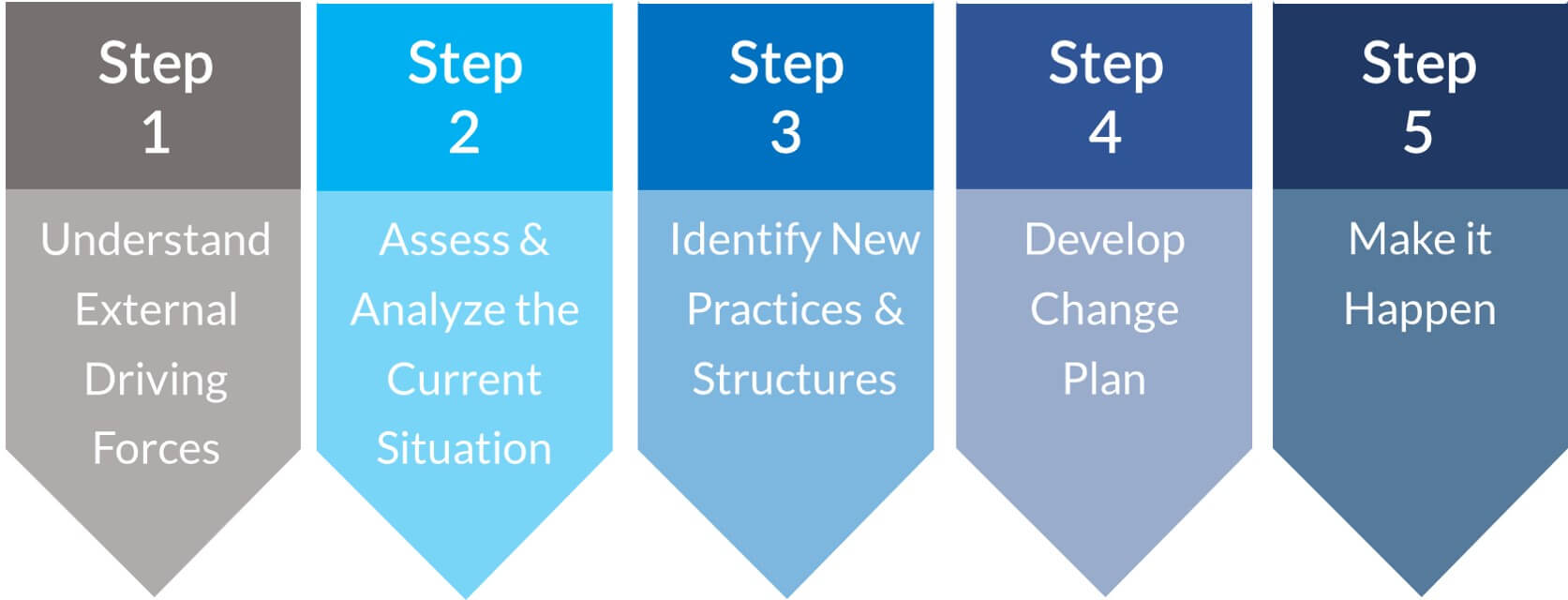
Step 1: Understand external driving forces. It is essential to explore the global context and meaning of the virtual workplace and core components as our first step. That means gaining clarity about the forces that have created the situation and what impact those forces have on business operations moving forward. We start with the future, to understand how our business strategy, structure, tools, and culture must be different for success.
Step 2: Assess and analyze the current situation. Next, we will reflect and document your current state. What is the starting point for our transformation? What is working, what is not working. Where are the current breakdowns and the breakdowns that can be anticipated?
Step 3: Identify new practices and structures. Transformation requires new behaviors, tools, practices, ways of working, and more. Together we will discuss best practices, innovations, and fundamental shifts so that you and your organization can prepare for a future unlike the past.
Step 4: Develop a change plan. Virtual transformation requires many layers of change to the organization. Planning must address behavioral change for employees and leaders as well as the adoption of new ways of working. Understanding the impact of these changes on constituents, communicating what needs to be different, and building effective learning programs is critical.
Step 5: Make it happen. None of it happens quickly, and nothing happens without change first occurring at an individual level. You will create a plan for transformation for yourself, your team, and your business. We will create accountability for you as you go through the course and ensure you are bringing in others in your organization for a collaborative, cross-functional effort.
Exercise 1.1: Virtual Workplace
Reflect and write down responses to the following questions.
• What drew you to this course? Why did you choose to participate?
• What crossroads do you find yourself at with respect to your professional life, work, career aspirations?
• What new possibilities do you see for yourself?
• In what ways do you see this course helping you?
B. Share your responses with 2-3 colleagues in the breakout room and be ready to participate in whole group conversations by sharing insights.

Course Manual: 1.2 Our VUCA World
We start our conversation with a review of the fundamental driving forces of today’s workforce. We will review two frameworks VUCA and Industry 4.0 to explore their meaning for leaders, connection to virtual transformation, and set you up to create a plan to address their existence while exploiting the opportunities they open.
VUCA is a concept that originated with students at the U.S. Army War College to describe the volatility, uncertainty, complexity, and ambiguity of the world after the Cold War and particularly after 9/11. Since then, business leaders have adopted the term to describe the chaotic, turbulent, and rapidly changing environment that became our new normal. The financial crisis of 2008 disrupted business models and organizations plunged into similar territory the military was seeing, technology – social media, demographic shifts, globalization, and all that was before 2020! Today the VUCA framework has gained new relevance as we seek to characterize the current environment and the leadership required to navigate it successfully.
We will address each of the forces identified separately for understanding while recognizing they are all interrelated and seldom acting independently. Also, it is often easier to understand what something is NOT. VUCA means we are no longer working in a stable, predictable, simple, or transparent environment.
Volatility: nature, speed, volume, magnitude, and dynamics of change, not stable. Think rollercoaster, something that is liable to lead to sudden change, could change for the worse, turbulent.
Uncertainty: The haziness of reality and the mixed meanings of conditions, not predictable. Think walking blindly out on a cliff: not established or confirmed, hard to plan, fraught with uncertainty or doubt, subject to change, inconsistent or undependable.
Complexity: The confounding of issues and the chaos that surrounds any organization, not simple. Think of an intricate mosaic: difficult to analyze or understand, a complex arrangement of concurrent things having interconnected parts.
Ambiguity: The haziness of reality and the mixed meanings of conditions not clear. Think dense fog: open to more than one interpretation, misleading, unclear
Does any of that sound like 2020 or the environment we are all working in right now?
Exercise 1.2 VUCA
Sign on to our interactive survey page and post your response to these questions.
Have you heard of VUCA before this course?
What does the acronym stand for?
Which of these forces do you find most irritating and unnerving personally?
How about your team? To what extent does each of these impact them?

Course Manual 1.3: VUCA Leadership Response
The good news is that we can flip the coin. For each of the VUCA conditions, there is a leadership response. Great leaders confront the reality that we live in a VUCA world. They lead in ways that enable employees, colleagues, and customers to be productive amidst the chaos and achieve results and competitive advantage. To embody this as a leader:
• Combat volatility with vision: look ahead proactively to anticipate change, and map a course that aligns with the organization’s values and goals.
• Fight uncertainty with understanding: knowing your organization’s strengths and capabilities will help guide business decisions when time is of the essence and problems need to be solved quickly.
• Best complexity with clarity: you don’t know what you don’t know, but there are things you do know. Focus on those so you can control what’s within your abilities.
• Attack ambiguity with adaptability. In times where you don’t know what to do, being flexible is your organization.
Exercise 1.3: VUCA Leadership Response
Pick a letter/force and reflect on an experience that illustrates that force in action?
What are you currently doing to lead through VUCA?
Map the leadership response with the VUCA force
What can you start/stop/modify to be a more effective VUCA leader?

Course Manual: 1.4 – Industry 4.0
Industry 4.0 is characterized by exponential change, artificial intelligence, a virtual world, and the continuous need to adopt new ways of working to remain competitive. With self-directed, tech-enabled, globally-connected teams, the work of managers and leaders will shift. Culture will need to be driven by leaders devoted to serving their team’s needs and helping them navigate through uncertainty to a radically different future driven by machine-man collaboration. Leaders and managers will be called on to ensure that virtual team members are coordinated and accountable to each other. The more traditional roles of recorder, gatekeeper, and process owner will fade away.
Industry 4.0 is characterized by the fusion of the digital, biological, and physical worlds. The growing utilization of artificial intelligence, cloud computing, robotics, 3D printing, the Internet of Things, and advanced wireless has put us on the verge of an industrial revolution that will surpass the impact of previous industrial revolutions. There is an explosion of new capability to increase work efficiency, our ability to scale and develop improved products and services.
Industry 4.0 enables personal services and productive work that can be achieved anytime, anyplace, through any mobile device. Ordering a cab, booking a flight, buying a product, making a payment, listening to music, watching a film, or playing a game—can now be all done remotely. Today’s workers can monitor a machine on a production floor, send out a communication to thousands of employees at a time, connect with teammates to collaborate on projects, and access all the information and tools they need for work using the same mobile devices that we have come to rely on in our personal lives.
Exercise 1.4: Industry 4.0
Knowledge Assessment or Breakout groups
What overlaps do you see between Virtual Transformation and Industry 4.0
• Where would you put your company on the Industry 4.0 roadmap?
• What specific industry 4.0 trends have you seen in your company or industry?

Course Manual 1.5: Virtual Workplace
Virtual workers are here to stay. In the future, teams will consist of members working from different locations at different times. The traditional hub and spoke team led by one manager in one physical place will be a rarity. Undoubtedly, some of the fundamentals of excellent management and leadership will persist, but future success will require a shift in mindset and capabilities. Success in a virtual world requires building an effective virtual workplace, leading constituents through complex transformation, developing new offers, and optimizing operations with technology enabled by the fourth industrial revolution.
Although there are benefits to virtual working arrangements, the inherent distance creates specific challenges for leaders. When leaders and employees rely on electronic communication to connect and complete their work, there are more possibilities for misunderstandings, significant barriers to fostering trust, and greater difficulty in coordinating. Virtual leaders must BRIDGE THE DISTANCE for themselves, their team, and their connections to other groups and organizations.

Course Manual 1.6: Personal Presence
During this portion of the module, participants will introduce themselves with a 2-minute presentation. We will provide feedback and debrief with crucial tips to ensure each participant is coming across as professional, strong, adept at using virtual tools, and has a suitable home office environment. Each participant will give a one-minute overview of themselves that they prepared in advance. Participants will observe to learn more about each other, and assess the participants’ leadership presence. We will do a group debrief identifying fundamentals that can be addressed to improve personal presence.
Exercise 1.6: Personal Presence
• Introduce yourself with a 2 min introduction letting us know who you are as a leader, and what you see as one of the most important challenges to address through this coursework.
• As others are introducing themselves, listen in an open way, and note any feedback you have to provide them to improve their virtual presence.

Course Manual 1.7: Virtual Communication Style
As prework, you took the “Working From Home” style assessment. Everyone has their own style and tendencies. When working virtually, we need to become more aware of our strengths and weaknesses and manage them. We don’t have our peers, leaders, and other influencers around us to help point out when we need course-correction. Time and priority management are vital. Your report’s tips are based on your survey responses and offer insight into how you might manage yourself when working virtually and how you can use tools like this to understand more about your employee’s and colleague’s styles. Great leaders use this knowledge to adapt their communication styles to the situation for effective communication.
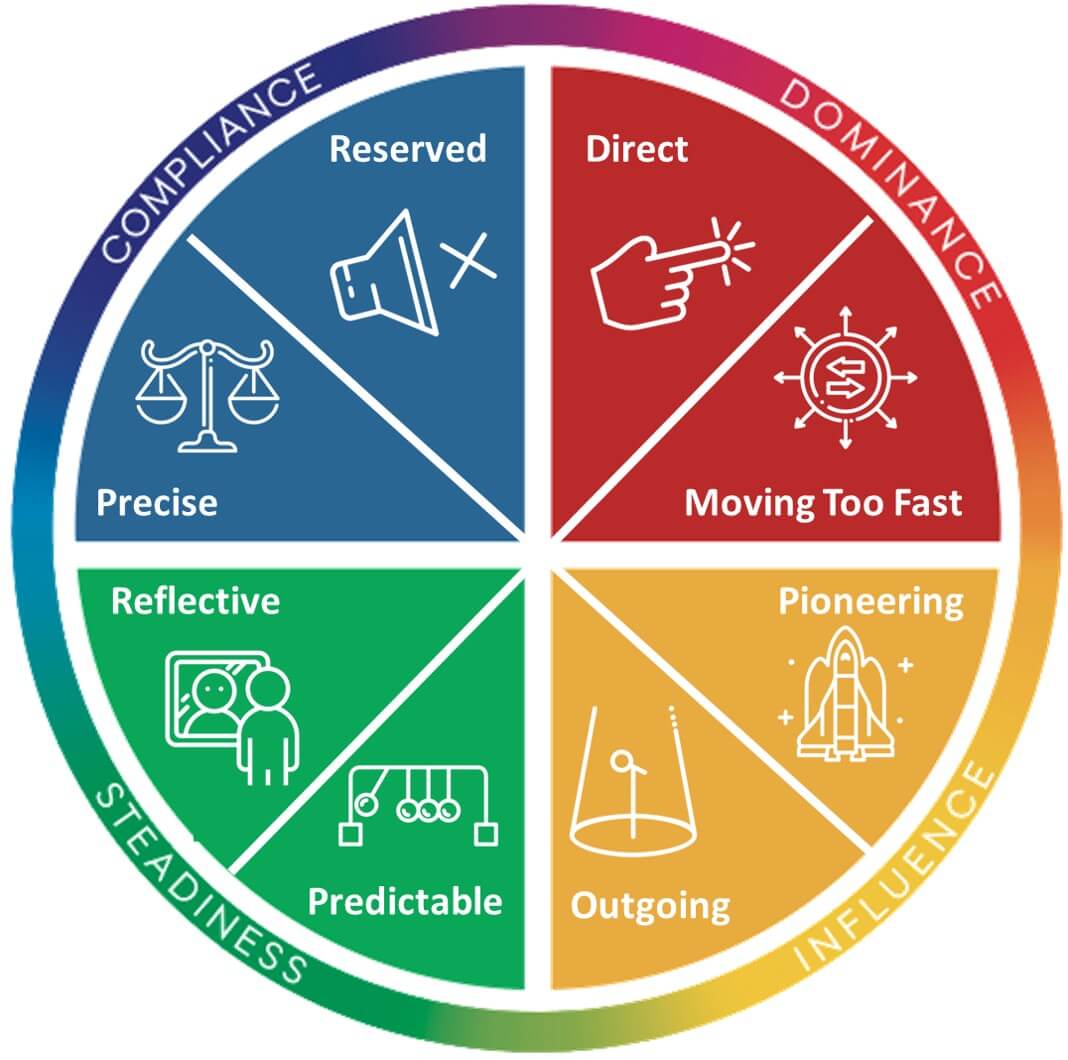
Working From Home Assessments
Here is a summary of each of the different communication styles and suggestions to improve personal effectiveness given that style. Use your personal assessment to understand your customized suggestions for your great success in a virtual environment.
Direct: Create a Clear Structure
Without clear instructions and check-ins, direct people can go off the rails and move at a breakneck pace. Direct communicators like task-oriented work and achieving high goals they set for themselves, but their tendency to bounce around on tasks can cause their team members to feel left in the dust.
Solution:
• Use a scheduling team tool like Basecamp or Monday to layout entire projects that break down into tasks. That way, High Ds can stay on tasks and work at their rapid, preferred pace without leaving their team behind.
• Encourage everyone to share exactly what parts of projects they’re working on, and build these checkpoints into projects. If reporting is just another step in the process, it won’t feel intrusive to Direct communicators while still remaining efficient.
Reflective: Over-Communicate for Excellence
Low Ds hate conflict and prefer to keep the peace. This can be a struggle on a hybrid team, where some team members can benefit from face-to-face communication while others can only rely on video chat and text chat. When communication isn’t happening in-person, low Ds can panic and become anxious.
Solution:
• While much of this anxiety must be self-managed, you can prevent miscommunication in the first place. Make sure to schedule one-on-ones with your Reflective team members and express gratitude to them on a regular basis.
• Offer constructive criticism but follow it up with a reassurance that their hard work is noticed. This is important for all team members, but especially for low Ds, who will not go out of their way to get feedback or ask for feedback.
Outgoing: Better Bonding = Better Work
Outgoing communicators have a high I score, which means they are people-oriented, talkative and driven by interaction. High Is have likely suffered heavily while remotely; without water cooler talk, coffee breaks, office inside jokes, and regular chances to connect with others, Outgoing communicators wither. They also are at risk of leaving others out unintentionally if they work with some team members in-person.
Solution:
• Have team bonding that is actually fun. Zoom cocktails have lost their appeal to many, so don’t make your team gather in the same way they do for meetings. Try playing a collaborative online game like Among Us or Overcooked, or have a lunch-hour watch party for a show your team loves.
• Something entirely unrelated to work will help everyone feel like they’re together again. That feeling goes a long way with Outgoing communicators.
Reserved: Focus On Clarity
While you’re thinking of the miscommunication that happens in hybrid teams, Reserved communications are definitely feeling that pressure. They are highly analytical individuals, and that eye to detail can cause them to read too much into written messages or even the small things like emoji choice in Slack.
Solution:
• Many people got used to remote communication in 2021, but that doesn’t mean they’re ready for hybrid teams. Make sure all team members are receiving the same amount of attention and information when tackling projects, noting successes, and giving feedback. Avoid sarcasm or any kind of figurative language that can be misinterpreted over chat.
• Reserved communicators won’t go out of their way to ask for clarification or more feedback, but when they receive those things, it enforces what they know about their work situation and will help them feel more secure.
Predictable: Slower Pace, Increased Anxiety
Steady communicators prefer a slow pace, defined responsibilities, and clearly outlined expectations. The pace can clip on a hybrid team, and there might be anxiety around reaching out to clarify expectations, especially if part of the team is remote and part is in-office.
Solution:
• Steady people want the opportunity to think through their projects multiple times, with their team and on their own. Make sure that expectations and instructions aren’t just delivered verbally; follow up with an email with deliverables and utilize your project management software. It might feel like overkill at times, but this process will save you a lot of time when your High S teammates can make sure they’re on track on their own.
• Make sure to get their input on the schedule of a project as much as possible. If you’re simply dictating due dates and project pace, your Predictable team members will feel overwhelmed and ignored; ask them what feels reasonable for deliverables and come to a compromise. This work upfront is worth it for success throughout the project and will increase their engagement in their work.
Dynamic: Moving Too Fast
Dynamic people, or Low Ss, love jumping from idea to project to task, without slowing down. This high-energy approach can cause problems when the obstacles of a hybrid team come into play — different time zones, working away from chat, not able to pop into someone’s office for the answer they need quickly.
Solution:
• Even if instant chat is an option, people can’t always immediately reply. Establish communication requirements and preferences early on in your working relationships on hybrid teams, i.e “Slack me for regular requests, email for more formal questions, and text me in an emergency”.
• These expectations will help lessen the anxiety about being ‘on’ all day for the rest of your team, but they will help Dynamic communicators prepare for how and when they get information from others. Also, make sure your Low Ss have plenty of tasks to work on at once, so they can jump around without disrupting other projects.
Precise: Adjusting to Others
Compliant communicators (High Cs) enjoy rules and clear expectations but don’t love hashing things out with others. This means they can overly rely on tools like chat and email while avoiding phone calls and video chat. This can cause a disconnect with other communicators who need some face time, and if they work on a hybrid team, they can retreat even further without regular team interaction.
Solution:
• Use different communication formats for different purposes. If you have a quick question, shoot off a chat, but use video chats for project launch meetings and one-on-ones. Remember that helping your High Cs push themselves out of their comfort zones will have positive benefits for their growth and their standing within your team!
• That being said, let Precise communicators select their preferred communication method as often as possible. Lessening sources of stress are key to increasing engagement, and the less friction on your hybrid team, the better.
Pioneering: Too Free Spirited
Pioneering communicators have a low C score, and they love forging their own path, but that can lead to troubles with a hybrid team. If they are enjoying the flexibility of working from home a little too much, the team might not be able to grab them at crucial moments. Their flexibility with communication formats and style might also confuse and discourage more rigid peers.
Solution:
• If you’re a low C and need time to think, plan, or simply get stuff done, mark it on your calendar clearly. If your best work comes after hours or before you’re on the clock, indicate that on your calendar and don’t be afraid to let your team know that preference. However, you need to be available on your ‘on hours’, so don’t check out, but do communicate your process and find a middle ground.
• If you’re managing a Pioneering communicator, help them figure out their communication cadence and productivity. Take advantage of their free-thinking and outside-the-box approach to find creative solutions, but remind them that paying attention to their team members is just as important.
Succeed With All Communication Styles
Overall, there are 3 things you need to do for success with all communicators on hybrid teams.
1.Over-Communicate: With your team partially at home and in-office, you need to make sure that everyone is always on the same page. Make sure the information they need is available over the phone, in-person, and over your shared project management system. If it feels like overkill, you’re doing it right.
2.Over-Clarify: A lot of people experienced high levels of anxiety and uncertainty when transitioning to remote work, and that uncertainty can carry over into working on a hybrid team. Offer consistent feedback and make sure that your team has the channels they need to express themselves and any concerns. Clear up KPIs and reinforce job descriptions (the benchmarking process can be particularly helpful for this task!).
3.Over-Appreciate: When we say over-appreciate, we don’t mean that you need to be full of simpering praise all of the time. It’s important to remember that the risk of disconnect and disengagement is higher for hybrid teams if they are not managed properly. Use the knowledge you have about each of your team members’ preferences to show them you appreciate their hard work and effort.
Hybrid teams are the future of the workplace. Use your knowledge of your team’s communication styles to help them succeed in their roles as soon as possible.
Exercise 1.7: Virtual Communication Style
Read and reflect on your report. Identify one thing you will either start, stop or modify to be more successful in leading virtually.

Course manual 1.8: Mindset Shifts and Capabilities
Success in the virtual workplace requires new capabilities and shoring up traditional capabilities like communications and building relationships. So much has been written and researched on Leadership. We have synthesized the top research on Modern Leadership here. And captured it in four capability groups: Personal Impact, Growth Mindset and Resilience, Taming and Collaboration, and Future Focus.
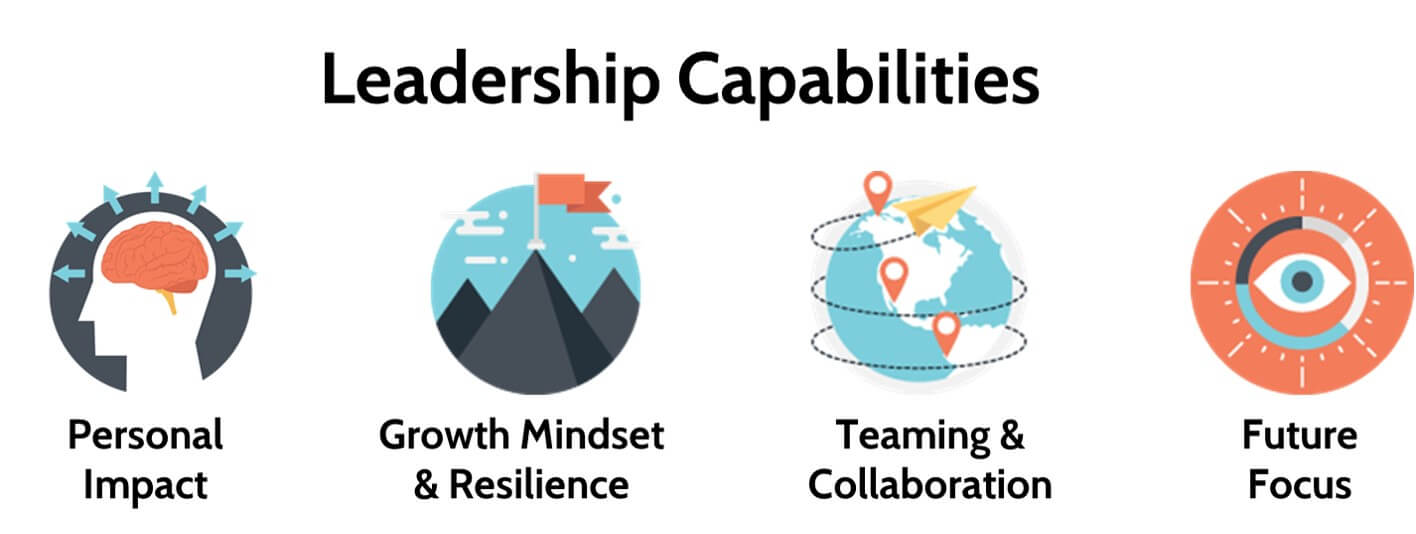
As we go through each of these. We invite you to reflect on the topics. We want to trigger you to think through each of them as it relates to yourself. Many of the words you’ll hear will sound like common sense, resist the urge to think to yourself “I know that already.” Lean in and consider where you can learn more and make a bigger impact. The great news is that all four of these leadership areas are skills that you can get better at with effort and practice. This is the heart of a growth mindset.
In a virtual workplace, leadership happens at all levels of the organization. A distinction of virtual leadership is that employees don’t work for a manager in the same location. It can even mean that employees don’t formally work for you. Which description represents your leadership situation at the moment?
• Do you lead through your own personal excellence and contributions?
• Are you a thought leader, influencer, or catalyst for change?
• Do you lead cross-functional projects?
• Are you a manager with direct reports?
• Do your direct reports lead their own teams?
Let’s go into each of the capabilities in more detail:
Personal Impact is living your vision and values with integrity, owning what needs to get done, It includes Leading others with your ideas, example, and commitment to the organization’s success. The key skills to develop are accountability, purpose and vision, thought leadership role modeling and followership.
Growth Mindset and Resilience is seeing possibility, believing in your own, other people’s, and the organization’s ability to GET BETTER. moving forward despite difficulties and setbacks. Your ability to process adversity and bounce back quickly. A growth mindset is quickly becoming the core of leadership development and may have started studying this within your organization. Resilience refers to having the self-awareness and management to move past the speed bump quickly and without getting derailed. The key skills to develop are Willingness to put in the effort, take on challenges and take smart risks, belief in the “power of Yet,” Feedback mastery, and the ability to manage your emotions and reframe thinking.
Teamwork and collaboration focus on Identifying essential collaborators and quickly getting up to speed on what they know so you can work together to get things done. It starts with creating connection and synergy which yields greater outcomes from working together than working alone. Success in this domain also means breaking free of organizational silos and geographic boundaries to work together, share resources, and take mutual responsibility for the whole. Key skills include building strong relationships and networks, aligning others around a shared purpose, adopting modern collaboration tools for the virtual workplace, and working across boundaries.
Future Focus consists of understanding future trends and their meaning for the organization, experimenting, and advocating new ways of doing things. And identifying a roadmap for leading your tribe to a successful future. Key Skills include reading the world and adapting, Innovation, colonizing the future, Influencing and leading change,
Exercise 1.8: Mindshifts and capabilities
Assessment and Breakout Room Conversations
Rate yourself as we debrief each of the Future capabilities, and share your top 3 and bottom 3 in your small group conversations.
• What opportunities do you have to transform as a leader, what would the impact be?
• Where can you share this learning with your team?
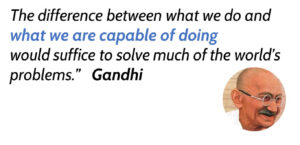
Course Manual 1.9: Leadership SWOT
To be successful in today’s market and build a competitive advantage for the future, business leaders need to leverage every asset they have. This means they must be aware of their own strengths, capabilities, and passions, as well as the strengths and capabilities of their employees. Once you are aware of these assets, successful business leaders arrange the roles and responsibilities of the organization to make the most of them.
Developing a personal SWOT (Strength, Watchouts, Opportunities, Triggers) is a way to be clear on focus on what are your strengths and where you have an opportunity to improve. It will allow you to reflect and understand what are your emotional triggers and become more aware, so they won’t impact you negatively.
This is a self-reflection assessment, there are no right or wrong answers. As you go through the questions in each section, think about your emotional triggers, what are the situations that trigger you and hijack your emotions. In this process you will identify the Strengths you possess, Watchouts to be aware of, the Opportunities that exist for you to take advantage of, and the Triggers that might hijack your emotions and impact your actions. On the template, answer the following questions:
Strengths
• What activities do you do well/excel at?
• What relevant knowledge, experience or natural capability do you bring to your role?
• What are your personality strengths?
• What activities do you have a passion for?
• What do others see as your strengths?
• Which strengths are required for success in your role?
Watchouts
• What could you improve?
• What are your limitations?
• Do you ever show up for others in a negative way?
• What causes negative moods?
• Where do you feel over committed?
Opportunities
• How can you turn your strengths into opportunities?
• What knowledge or experience could you gain to address current weaknesses?
• What resources do you have available to you to increase your capacity to act?
• How can your peers help you?
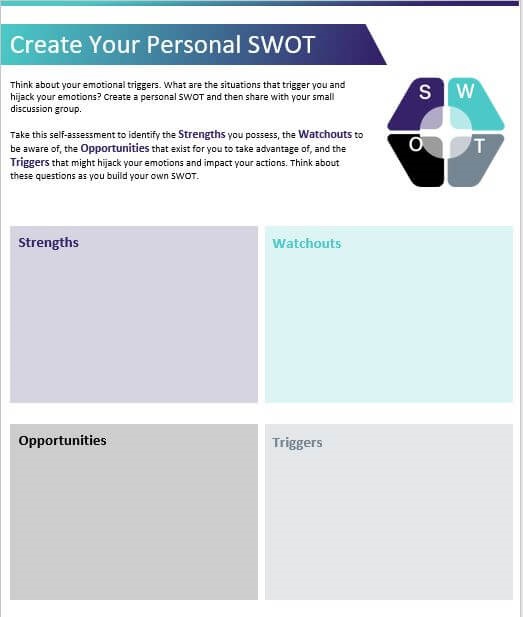
Exercise 1.9: Leadership SWOT
Once you complete your SWOT take the time and reflect on your answers. Remember, no one else will see this, so make sure you were totally honest.
Strength:
• Are there any surprises?
• Are you confident in your strengths? Would others agree?
• Are you using your strengths to their fullest potential?
• Are these the right strengths for someone in your role?
Watchouts:
• How often do you experience a watchout during work?
• Are you now more in tune to your watchouts?
• How will this change how you work?
Opportunities:
• What are some specific steps you can take to make a change?
• Who do you need to reach out to for assistance?
Triggers:
• How often do these triggers happen at work?
• Do these impact how you work with others?
• What are some ways you can regulate or “get back to clear”
Now, develop a plan. Solidify each action, what steps do you need to take to make a change? Who do you need to work with? How will you track your progress and success? Give yourself achievable actions and a timeline. Share this with a peer or your manager to keep yourself accountable.

Course Manual 1.10: Leading Change Framework
This section is designed to provide an introduction to the key concepts influencing the success or failure of change implementation efforts and to apply them to the change initiatives relative to the virtual workplace and new normal. Every month during this course we will take a deep dive into another element of successful change leadership, and you will move through your own change plan as part of your ongoing project.
Leading change is 80 percent people management (establishing direction, aligning, and motivating), and 20 percent content (problem-solving, planning, and organizing.) Most change efforts fail because sufficient attention isn’t given to the powerful people that dramatically affect the final results.
Expectations can play an important role in generating motivation for change. Managing change requires extensive attention to managing the expectations of those who need to change. The degree of difference between what I expected would happen and what I am now faced with is directly correlated to the degree of resistance I will have to the change effort.
Follow this process to make change real.
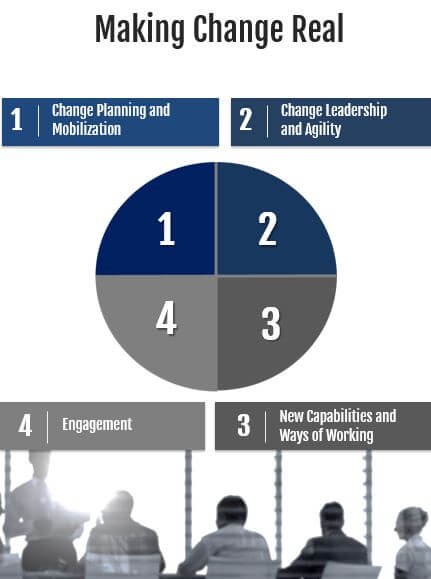
1.Change Planning and Mobilization
The discipline of considering impacts before rushing into action. Leaders need to clarify specific objectives, scope, timing of the intended change. This is accomplished through conversations about the impacts the change will have on the organization at an enterprise, program, and employee level. The goal of this phase is to develop specific strategies for successful implementation, ensuring there are real structures for sustaining the change.
Tools and Strategies for Change and Mobilization:
• Blueprint
• Gap Analysis
• Impact & Exposure Map
• Integration with other initiatives
• Assessments
• NewSDoG
2.Change Leadership and Agility
Embed change agility into the organizational DNA for present and future success. One thing is for certain, more change will be coming. Our goal is to wire the organization for success now and in the future. This is achieved through the use of proven and consistent tools and practices – a playbook for leading change. Leaders are mentored and given the tools to develop the capability for leading change.
Last but not least, prime the organization for change and identify behaviors required for an agile, adaptive culture.
Tools and Strategies for Change Leadership and Agility:
• Leading Change learning curriculum
• Emotional Intelligence
• Instituted tools & practices
• Clear expectations & distributed accountability
• Conversations for Change
3.New Capabilities and Ways of Working
Transform how work is done. During this phase, work is done to identify and build the needed competencies and behaviors required for success. Create new structures for development and sustained change. Then focus on preparing for the future of work.
Tools and Strategies for New Capabilities and Ways of Working:
• “Professional of the future” competencies and career path model
• Talent Review and acquisition plan
• Aware/Adopt/Adapt/Use model
• NewSDoG
4.Engagement
Accelerate change and make the most of the organization’s human capital.
Engaging all constituents affected by the change to ensure their support, commitment and adoption of new ways of working is the accelerator for change. We will work to help you increase urgency, collaboration, and creativity throughout the teams and organizations impacted.
Tools and Strategies for Engagement:
• Stakeholder analysis
• Strategic planning
• Engagement events
• Assessing and monitoring
• Creating communities
• Two-way communication
• New technology
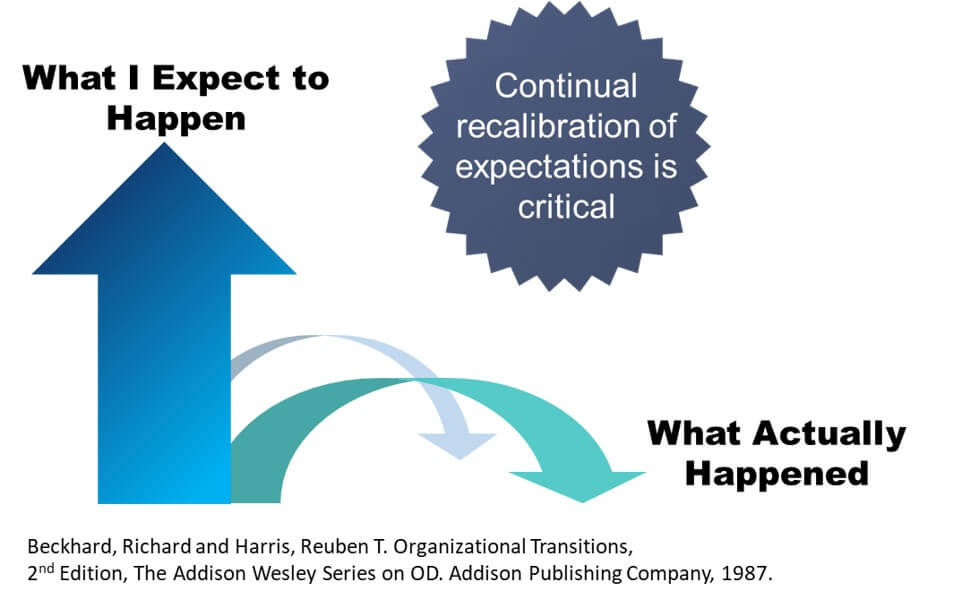
Critical Success Factors:
• Clearly understand the expectations of the “targets” of the change and have a robust communications plan.
• Take the actions necessary to ensure adequate capacity within the organization to absorb the change by managing demand.
• You must have a balance between all three elements of the triple constraints – When any of the three legs shifts, so must the others.
• Ensure a comprehensive change effort rather than one focused on one component of the STAR model.
• Build commitment with good planning on the front-end – Rework is expensive and frustrating for the organization.
• Ensure a balanced solution (50% tools/50% consequences).
• Obtain adequate sponsorship. (Resource AND consequence management.)
• Use of a structured change model such as impACT helps frame the change effort and guide actions.
ImpACT change management process:
1. Achieve a Shared Vision: Guides you as you establish the business case, confirm the need for change, and develop a shared vision of what the future will be once the change is implemented.
2. Create Commitment and Plans: Helps you plan to close the gaps between where you are today and where you need to be by mobilizing commitment and planning the change.
3. Take Action and Sustain the Change: Helps you manage the implementation of your action plans, monitors your progress, and describes actions you’ll take to sustain the change. (This phase is most helpful to the team well after the plan is already executed.)
Exercise 1.10: Leading Change Framework
Try to write with your non-dominant hand. What is the experience like? How can you relate it to change?
Get started on your Project work by reflecting on these questions.
What is the problem you are trying to solve?
What is the opportunity if the change is made?
What happens if you do nothing?
Who is the customer for this change effort?
From the customer’s point of view, what does success look like?
How will we know when we’ve been successful?
What is the one-sentence vision of success?
What are the metrics to measure our success?
What is in scope or out of scope?
What are the assumptions about this change project?

Course Manual 1.11 Seize Tomorrow: Designing Your Future
Once you have a clear perspective of your current state, we will turn the conversation to the future. Based on your understanding of the forces that are impacting our world, how do you need to shift yourself as a leader, the way your team works, and how your business compete? What is the picture you must paint of the future to get people to follow you? What do you anticipate based on the trends you have researched, and how will you prepare for a future, unlike the past. Using appreciative inquiry we will begin to articulate your desired state, and what you need to build and develop to achieve that vision.
Exercise 1.11 Seize Tomorrow: Designing Your Future
Each participant will select a visual from the Center for Creative Leaderships Visual explorer set. The exercise is to create a metaphor from the vision to answer the questions and articulate your thoughts on…
What is your vision of a transformed virtual workplace?
What do you need to do/build as a leader to be successful in that future?

Course Manual 1.12: Making it Real
At the end of each workshop, we will collectively turn our focus into how you as a leader will make what we have covered real in your organization. By making it real we mean to apply what you have learned and take the action required to make a positive impact. That starts with reflection on what you are going to do differently yourself and a commitment to change. Also important is how you will bring the others in your organization into the conversation about what you have learned, and make requests about what you need from them for success. This will include not only your formal team but your cross-functional peers. How will you collectively build the plan to transform yourselves into a virtual organization?
Now it’s time to create an action plan. You don’t want to settle for only inspiration. You want your inspiration, combined with your determination, to create transformation. You’ll create your action plan in four steps.
The first step is a start | stop exercise. If you’re going to start or embrace new attitudes, perspectives and behaviors, then you need to stop other attitudes, perspectives, and behaviors. In the start |stop section, list the things you know you must stop doing. Write down any attitudes, perspectives, or behaviors that relate to you, your boss, your organization, your team, or your personal life including family and friends. What paradigms and practices do you realize are either untrue or unhelpful? Record all of these in your stop list. Then, in light of that stop list, think about the attitudes, perspectives, and behaviors that you want to start implementing. The start column should again include perspectives, paradigm shifts, and key practices you now want to embrace in your quest to become a more effective and engaging leader. This start | stop exercise will help you to leave behind the things that are untrue and unhelpful while focusing on the things that will make a difference moving forward.
Build upon your start | stop list as you move to section two. In this exercise, you will identify your top priorities. Who do you want to start leading more effectively – your boss, your team, your direct reports? Are there certain projects, places, or situations where you know you could lead with greater clarity of purpose? Identify these goals and priorities as well as the people who will hold you accountable, the paradigm shift needed, and your next best step.
The third section centers on inviting others. In this exercise, you will share your action plan (specifically your start | stop list and top priorities) with at least two others. We suggest you start with your boss and a colleague. Invite these people to give feedback about your action plan. Are you on the right track? What aspects need adjustment so you can craft the best action plan possible? Ask for their support and encouragement. Most importantly, ask them to hold you accountable and to regularly review your action plan with you, helping you to seize the opportunities for growth.
Now, as you look at your action plan, what are your most immediate next steps? Identify what you can start doing tomorrow, or next week, to put your action plan into practice. Write out clear perspective shifts, behaviors, and practices you are going to specifically start implementing to move your action plan from a lofty ideal to reality.
Exercise 1.12: Making it Real
Reflect on and share something you need to start, stop or modify.
What was your biggest insight from today’s session?
1. START/STOP EXERCISE
If you are going to embrace new practices, you must leave behind old ones. What do you need to start doing? And stop doing? Make a list. In light of all the hard work you’ve done in this model and the insights that have been triggered about what you already know. You will create an action plan to put into practice. You’ll use the information you have gathered, including input from face-to-face interactions, to complete the exercise below.
2. TOP PRIORITIES EXERCISE
In light of your Start/Stop Exercise, identify your top priorities. How do you want to start recalibrating your ideas and strategies around “purpose” within your organization?
3. INVITING OTHERS IN
Decide who’s the best to keep you encouraged and accountable. There are several keys to choosing an accountability partner:
• choose a person with whom you can be yourself,
• has your best interest at heart, is willing to meet with you frequently and
• is willing to speak the truth.
You are not looking for a lot of voices here, but rather just a couple that you trust and who can offer clarity and accountability. List the people below you will invite into this conversation and by when.
4. NEXT STEPS
Identify what you can start doing tomorrow, or next week, to put your action plan into practice. Write out clear perspective shifts, behaviors, and practices you are going to specifically start implementing to move your action plan from a lofty ideal to reality.
Project Studies
Please complete the following exercises reviewed during our workshop prior to workshop 2.
• Develop your statement of Purpose/Values in the context of the virtual world and our new normal
• Identify 3 articles to further research topics discussed including VUCA, 4.0 and leading virtual teams
• Move forward with your virtual team by Recontracting. Share article “Let’s Not Go Back to Work, Lets Go Forward” and hold a recontracting session with your team.
• Map out your Change Plan using the ImpACT Model and worksheets (See Manual 11)
• Use the Making it Real exercises
o Have conversations with peers, direct reports, managers and other stakeholders
o Identify personal behavioral change (start/stop/modify)
o Complete your action plan for this module
Program Benefits
Marketing
- Virtual workplace
- Customer experience
- Market growth
- Product innovation
- Predictive insights
- Increased productivity
- Competitive advantage
- IOT production optimization
- Return on investment
- Future readiness
Management
- Change leadership
- Improved communication
- Empowered employees
- Continuous improvement
- Increased collaboration
- Global localization
- Augmented intelligence
- People leadership
- Optimized functions
- Innovation
Human resources
- Performance culture
- High impact teams
- Great workplace
- Virtual workplace
- Healthy organization
- Engaged employees
- Growth mindset
- Manager excellence
- Personalized development
- AI driven
Client Telephone Conference (CTC)
If you have any questions or if you would like to arrange a Client Telephone Conference (CTC) to discuss this particular Unique Consulting Service Proposition (UCSP) in more detail, please CLICK HERE.














